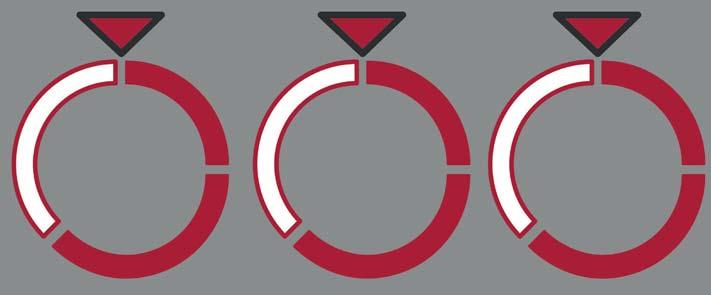DIGITAL: TALKING THE SAME LANGUAGE
OVERCOMING DIGITAL FRAGMENTATION

SHAPE OF THINGS TO COME
PLOTTING GREEN CORRIDORS





























DIGITAL: TALKING THE SAME LANGUAGE
OVERCOMING DIGITAL FRAGMENTATION

SHAPE OF THINGS TO COME
PLOTTING GREEN CORRIDORS




























As our story Port and Terminal Investors CrowdIn, on p11, makes clear there is a lot of activity at the moment directed at buying into terminal sector opportunities with much of this coming from shipping lines. As PS goes to press there is more of this news with Hapag Lloyd signing a binding agreement via which it will acquire 35 per cent of JM Baxi Port & Logistics Limited from a Bain Capital Private Equity Affiliate. Furthermore, Hapag Lloyd is to subscribe to a capital increase by the company and raise its shareholding to 40 per cent.
The deals keep coming, with much evidence of the shipping line penetration into the terminal sector – sometimes as part of an overall effort to diversify along the supply chain and in other instances just to build a position in the terminal world.
Many of the deals, or combination of deals, are of such a scale that it is hard to imagine shipping lines repeating the actions of the past and disposing of port assets when the ‘hard rain falls.’ The theory seems to be, if you get involved on a large enough scale you move out of the arena of a niche investment and add another pillar to your business which represents a healthy and complementary area of diversification that will play a significant part in sustaining you through tough times and boosting overall performance in the good times.
Will it work? Watch this space…
There are those that believe that down the track the disposal of certain terminal assets by lines is a distinct possibility. Coupled with this there is expected to be more involvement by private equity, infrastructure and pension funds in the port sector – the high profile of the logistics sector during Covid has helped to build this interest.
As we enter 2023 there certainly promise to be interesting times ahead, with many commentators forecasting a challenging period of contraction, suggesting, in turn, as The Economist puts it on p19 that its “Time to batten down the hatches.” The Analyst and The New Yorker columns, on p18, subscribe to a similar point of view, highlighting how a new planning canvas is in prospect and an era that presents a difficult decision-making environment.
If you haven’t had enough to think about after you have read these pieces, then dive into Andy Penfold’s Shape of Things to Come article on p24. This sees a tighter business climate having a far-reaching impact on the terminal sector.
There is plenty of food for thought.
Happy New Year!
The international magazine for senior port & terminal executives
EDITORIAL & CONTENT
Editorial Director: Mike Mundy mmundy@portstrategy.com
Features Editor: A J Keyes keyesj186@gmail.com
Consultant Editor: AndrewPenfold andypenfold@yahoo.com

Regular Correspondents: Felicity Landon; Stevie Knight; John Bensalhia; Ben Hackett; Peter de Langen; Barry Parker; Charles Haine; AJ Keyes; Andrew Penfold; Oleksandr Gavrylyuk Johan-Paul Verschuure; Phoebe Davison
Production David Blake, Paul Dunnington production@mercatormedia.com
SALES & MARKETING t +44 1329 825335 f +44 1329 550192
Media Sales Manager: Arrate Landera alandera@mercatormedia.com
Marketing marketing@mercatormedia.com
Chief Executive: Andrew Webster awebster@mercatormedia.com
PS magazine is published monthly by Mercator Media Limited, Spinnaker House, Waterside Gardens, Fareham, Hants PO16 8SD UK t +44 1329 825335 f +44 1329 550192 info@mercatormedia.com www.mercatormedia.com
Subscriptions
Subscriptions@mercatormedia.com
Register and subscribe at www.portstrategy.com
1 year’s print subscription £295.00
1 year’s digital subscription with online access £228.50
For Memberships and Corporate/ multi-user subscriptions: corporatesubs@mercatormedia.com
©Mercator Media Limited 2023. ISSN 1740-2638 (print) ISSN 2633-4232 (online). Port Strategy is a trade mark of Mercator Media Ltd. All rights reserved. No part of this magazine can be reproduced without the written consent of Mercator Media Ltd. Registered in England Company Number 2427909. Registered office: c/o Spinnaker House, Waterside Gardens, Fareham, Hampshire, PO16 8SD, UK.
Another year and plenty of challenges in the offing. There have been significant structural changes in the terminal sector –notably the increased penetration of liner operators. Will this stand the test of time? Financial entities are also forecast to have a larger role to play, encouraged by some recent healthy “cash-outs” by certain of these parties from early deals and by the generally higher profile of the sector generated in the covid era
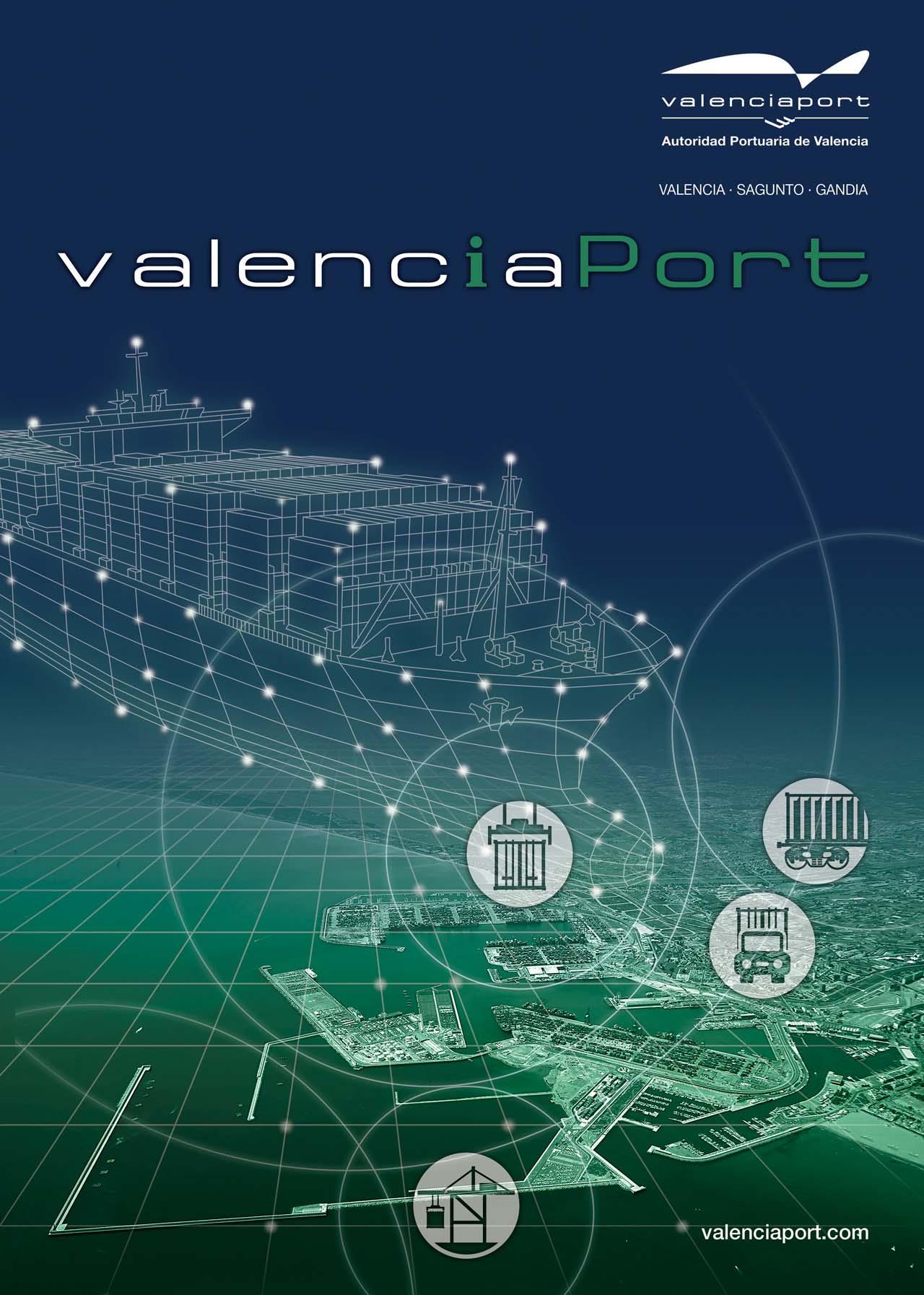
The
Talking the Same Language highlights the innovative work of the iTerminals4.0 project to develop and test – in real operations – a standard digital language that allows for twoway communication between port equipment and terminal operations management systems. Equally, the article Overcoming Digital Fragmentation underlines how the removal of digital fragmentation will provide a major catalyst to digital transformation
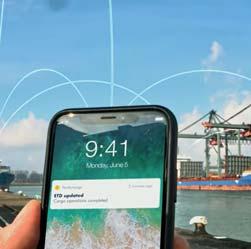
(Picture: Port of Singapore Authority)
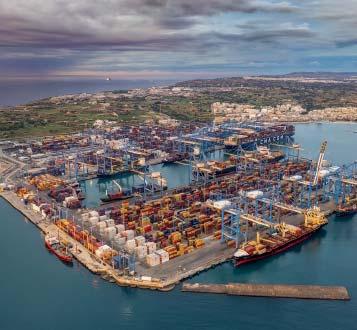
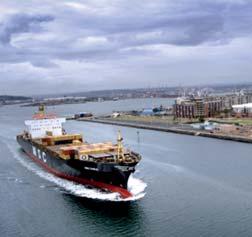
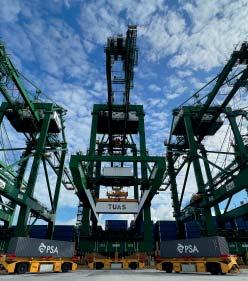
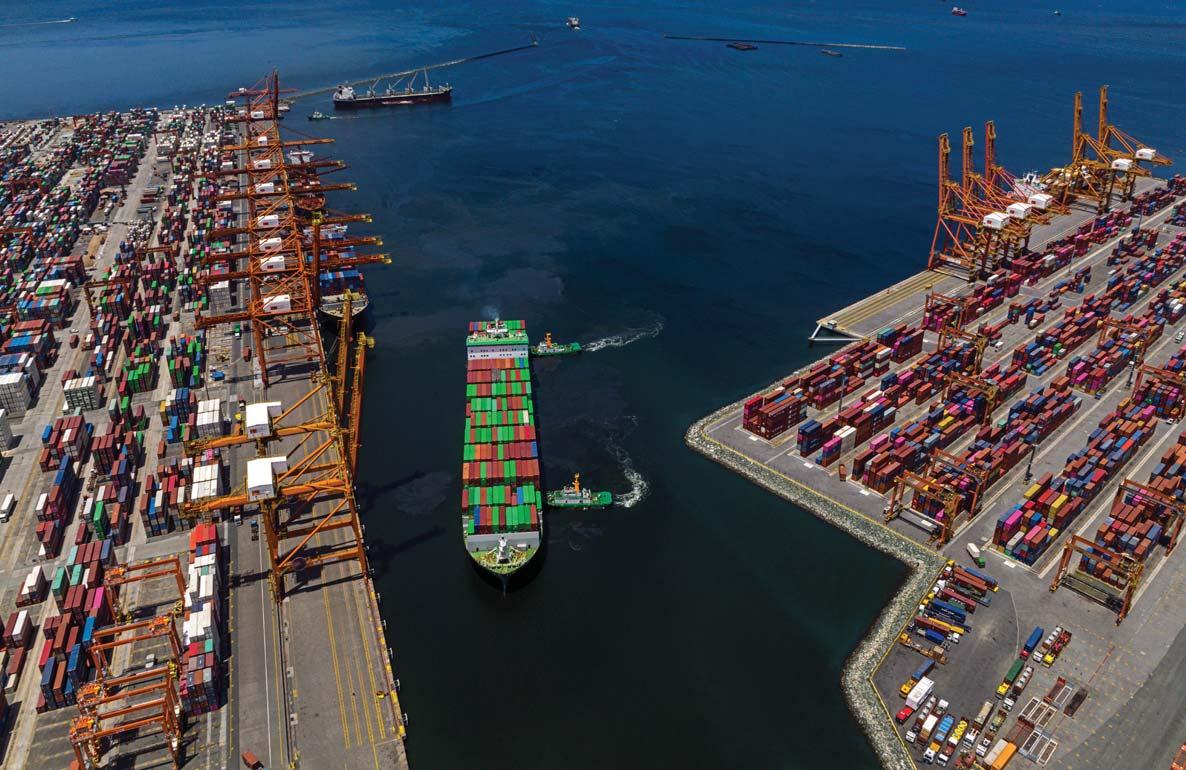
These are trying times, but we are resilient, responsive.
Despite the many challenges in this unprecedented time, we continue to quickly and safely deliver basic goods, food, medicine and supplies. With tireless, selfless men and women at the forefront, we are able to deliver essentials needed by societies and economies to heal and recover.
WE ARE STRONGER THAN EVER.
Hutchison Ports has exited the Dar es Salaam container terminal concession after failure to reach agreement with the Tanzania Port Authority (TPA) on the extension of its tenure there. Negotiations reportedly took place right up to December 2022 but the TPA formally took over the facility on 1 January 2023 with Adani Ports & SEZ appointed as what TPA describes as a service contractor on a monthly fee basis.
Hutchison’s exit took place against a background of a strained relationship with the TPA. There had been financial tensions a few years back – in September 2017, the late President John Magufuli instructed the TPA to review its contract with Tanzania International Container Terminal Services Inc (TICTS), Hutchison’s Tanzania business unit, with this resulting in a doubling of annual fees to the port authority, from US$7 million to US$14 million. The agreement between the two parties was also cited by Prof. Musa Assad, Controller & Auditor General, National Audit Office of Tanzania, 2014 – 19, as having major defects.
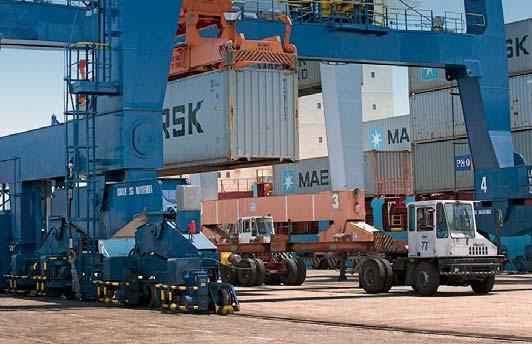
At a performance level there have also been regular problems relating to vessel berth waiting and container dwell times. Typically, in February 2020 waiting time for a berth at TICTS was reported by Hapag Lloyd as between 16 to 19 days and as recently as December 2022 as 8 to 10 days by Maersk. Not all of the congestion generating problems can be sourced to TICTS – there have been negative impacts from diverse sources:
Customs’ requirements, inland depot operations, truckers, container scanning requirements etc. but, as often happens to terminals, TICTS ended up ‘in the eye of the hurricane.’
External agencies such as the World Bank have in the past also criticised the port’s performance – suggesting that it can do better both in the context of serving Tanzania and the surrounding landlocked countries via the Central Corridor - Malawi, Zambia, Burundi, Rwanda, Uganda, and Eastern DRC.
Looking to the future, Plasduce Mbossa, Director General, TPA, has made it clear that the port will endeavour to find a new investor for Dar es Salaam’s container terminal. Equally, he emphasised when he took up his post, in mid-2022, that working with private sector companies to deliver a high level of efficiency is a priority and as such this goal is expected to figure large in the operator selection process for the container terminal. There is no word yet on the precise process that will be employed to achieve this but the logical path,
The governments of the UK and Scotland have announced plans to develop two new Green Freeports at Inverness and Cromarty Firth and Firth of Forth. The UK government is providing up to £52 million (US$63.3 million) in funding, with the initiative expected to generate an estimated £10.8 billion (US$13 billion) of private and public investment and create more than 75,000 new jobs. Sites in North East Scotland, Orkney and Clyde were not approved.
8 Offering a concession for the Dar es Salaam container berths via an international tender is in prospect with the port’s desire to boost efficiency levels central to this
especially given the desire to improve efficiency, is an international tender based on a multi-criteria bid – technical and financial aspects.
There have also been reports that the TPA is considering offering a concession for berths 5 to 7, in addition to berths 8 to 11 for the container terminal.
TPA currently operates berths 5 to 7, where approximately one third of the port’s annual container volume is handled as well as a variety of other cargoes. One option could be for the TPA to consider offering all these berths as one concession which would provide economies of scale and could offer advantages in pursuit of higher levels of efficiency. It would also give more flexibility to TPA in conjunction with its planned berth upgrade works at berths 8 to 11. Berths 1 to 7 have recently been reconstructed and provided with a depth alongside of 14.5m.
UK-based PD ports has raised a total debt facility of GBP710 million to refinance existing debt and provide for future business growth.
The 5-year arrangement, organised in conjunction with a syndicate of international banks involved in the infrastructure
sector, comprises a term facility, capex facility and RCF.
CIBC acted as coordinator, lawyers Hogan Lovells advised PD Ports – Linklaters acted for the lenders.
PD Ports continues to facilitate the growth of industry around its key port facilities, a notable recent
project being the establishment of the UK’s first large-scale lithium refinery at Teesport. The GBP500 million project will be used to provide battery materials for electric vehicles, renewable energy and consumer technology supply chains. Commissioning is scheduled for 2025.
The International Association of Ports & Harbours (IAPH) has released a new publication focussing on newly-created risk and resilience guidelines for ports as well as established a new risk inventory portal aimed at sharing best practices on risk mitigation and management for ports. IAPH aims to support ports in establishing a structured approach towards risk management and delivering business continuity and organisational preparedness.
The Swedish Government has given approval for Ports of Stockholm to apply for EU grant funding for pilot studies to develop onshore power infrastructure. The process will be undertaken in conjunction with eight other Baltic Sea ports seeking funding from the EU Connecting Europe Facility (CEF) that aim to gain support for facilities enabling more sustainable shipping with low air pollutant emissions. The application is called ‘Baltic Ports for Climate’ and partners are Aarhus, Klaipeda, Ventspils, Helsinki, Riga, Tallinn, Gdynia, and Hamburg.

Although Brazil’s Mario Franca, Brazil’s new Ports and Airports Minister, has strongly hinted that the urgently needed STS10 new container terminal concession for Santos will go ahead there could be a spanner thrown into the works as another port terminal, Ecoporto, lays claims to a sizeable chunk of land designated for STS10.
Outgoing Santos Port Authority (SPA) president Fernando Biral has said that some of the cash from recent years’ profits made from port operations – a record Reais416 million (US$80m) for
A leading Chilean logistics association has joined in with the country’s Maritime and Port Chamber (Camport) in calling for increased “public-private co-ordination” to combat violent criminal gangs stealing from container operators.
Colsa (the Logistics Association for San Antonio) has thrown its weight behind other Chilean agencies and companies involved in security - both private and public – to face up to the increasing “multi-million dollar thefts” from port areas in San Antonio.
The extra push for cooperation comes in the wake of a massive heist on January 11 which saw a well-organised criminal gang steal 13 containers stuffed with copper, valued at Pesos3,600M (US$4.414 million), belonging to state-owned Codelco. According to San Antonio police, 10 heavily armed
The International Container Terminal Services Inc. (ICTSI) subsidiary in Mexico, Contecon Manzanillo (CMSA), has commenced the third phase of its expansion project. This development will see capacity increase from 1.4 million TEU per annum to more than two million TEU per annum within the next fi ve years. Investment, which will span terminal infrastructure and quay and landside equipment,will total more than US$230million.
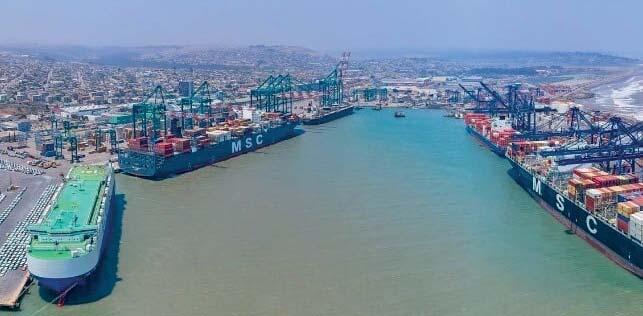
the first nine months of 2022 (see p31) - will go to a fund to pay “outstanding debts” to some operators, including Ecoporto. And a source very close to Ecoporto, a container and breakbulk terminal, notes that its area, of 126,000 sq m, is destined, according to SPA’s PDZ Master Plan, to be part of the 570,000 sq m that will form STS10, but if a “compensation agreement” is not reached with SPS and/or the Ports Ministry, then it will go through the courts and that could delay the process for up to five years.
In a nutshell Ecoporto, according to the reliable source, is saying the SPA must provide Reais300M (US$60M) compensation for the terminal handling equipment (including three virtually unused ZPMC STSGCs) it will hand over to the winning STS10 bidder plus another Reais1bn ($196M) for a “contract discrepancy.” Ecoporto’s operational area should have been 40,000 sq m larger when it began its concession some 20-years ago. While the concession has now ended, aside from a short short-term extension
to July, Ecoporto still has an active claim for compensation.
The way Ecoporto sees it, SPA has two choices; either they pay up most of the Reais1.3bn compensation claim or allow it to continue to operate with a renewed concession for another 20 or 25 years, which Antaq originally gave them permission to do. If not legal proceedings will be issued and that will be very time consuming.
Indeed, a source at Ecoporto reports that preliminary legal actions have already been initiated.
8 Colsa (the Logistics Association for San Antonio) is the latest organisation to call for increased “public-private co-ordination” to combat violent criminal gangs stealing from container operators
united effort from all parties.”
men entered the compound during the early hours, threatening staff before driving off with the containers.
This heist follows a series of attacks on container train and railroad facilities in northern Chile last October which forced the Chilean government to tighten security on all trains carrying copper.
“Companies associated with
Porto Itapoá, the rapidly growing container terminal in southern Brazil, in which Maersk has a 30 per cent stake, has just dded another 50,000m2 to its operational area increasing it by around 20 per cent and further expansion is in the pipeline of up to 150,000m2
Five ZPMC Mobile Harbour Cranes have been added to 17 of the same units already operating in Itapoa, which competes for cargo with the ports of Itajai and Paranagua.
Colsa request support from the national agencies in charge of security to face the increasingly frequent theft of millions of dollars of goods, which is seriously affecting the extra-port area of San Antonio,” Colsa emphasised in a statement. “It is beyond the resources of individual companies to deal with the sophisticated nature of these attacks so we are requesting a
December’s World Cup in Qatar gave a massive boost to Tecon Rio Grande (TRG), the box terminal owned and operated by Wilson, Sons in Brazil’s southernmost state. Between January and the end of November 2022, TRG doubled its boxed exports to the Middle East country, compared to the same period in 2021, with frozen chicken accounting for around 85 per cent of the total. For processed chicken, 495 reefers were shipped.
Three long-standing logistics companies, SAAM Logistics, Ultramar San Antonio and Agunsa Extraportuarios SA, also threw their weight behind moves to present a united front to fight the frequent heists.
“This type of situation exposes people who carry out their daily, operational tasks and safeguard our logistics centres, and these violent robberies do tremendous damage…” underlined Jorge Guajardo, Manager, Ultramar.
Dynamar has recently launched the 12th version of its annual perishable cargo publication, the Dynamar Reefer Analysis 2022. The publication comprises three main sections: two sections on container reefer trades and one section analysing the structure of the conventional reefer market. Forecasts for perishable trade volumes for full year 2022 and 2023 as well as for vessel fleet development are included.
15 17 TO FEB Newcastle Australia

Book your place now to join 150 ports

•Options for ports to combat climate change
•Net Zero Carbon Cruising
•Green Financing for Sustainable Port Development



•Pathways to Sustainable Ports
•Green Ports - What components are needed?

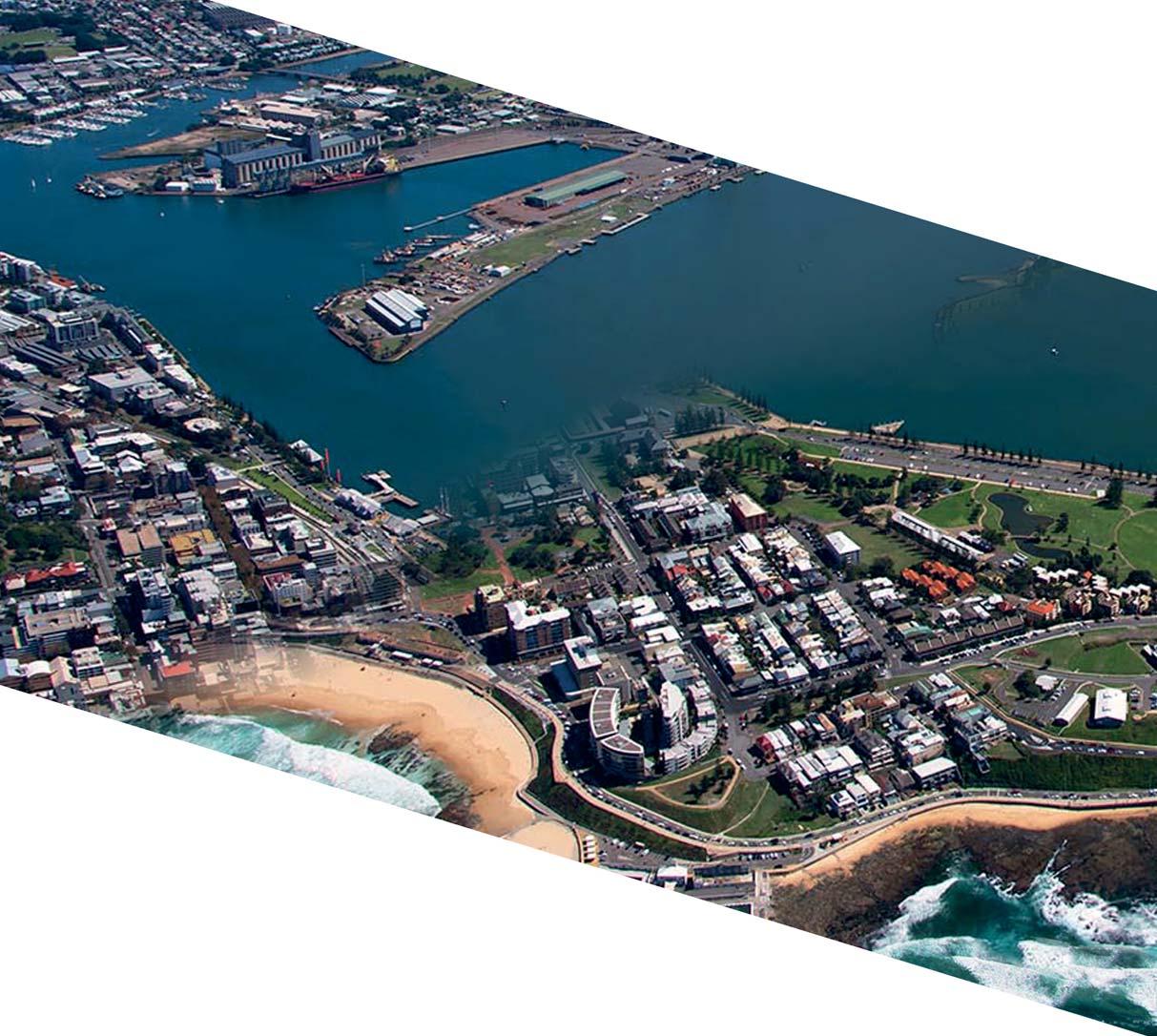
Host port:
Gold sponsor:
Silver sponsor:

Sponsors:
•Two day conference
•Full documentation in electronic form
•Lunch & refreshments throughout
•Welcome Reception
•Conference Dinner
•Port Tour
tel: +44 1329 825335
email: congress@greenport.com
visit: portstrategy.com/greenport-congress-oceania
Supported by:
There is an array of news this month from around the globe regarding investment in port and terminal businesses.
MSC confirms that it has completed the acquisition of Bollore Logistics which includes 16 African container terminal concessions and seven ro-ro terminals. It has similarly reported completion of the acquisition of Terminal Darsena Toscana (TDT), a container terminal facility in the Port of Livorno, Italy.
Hapag Lloyd, following on from an agreement to acquire a stake in the terminal business of Chile-based SM SAAM. has closed the purchase of a 49 per cent stake in the terminal operating company Spinelli active in the port of Genoa, Italy.
The Turkey-based terminal operator Yilport has announced a US$700 million investment in the port of Takoradi in Ghana targeted at building and operating a port complex. The project includes developing the existing container terminal to offer a capacity of 2.25m TEU and multipurpose berths for liquid, bulk, and general cargo operations offering a combined
capacity of around 20m tons per annum.
Ocean Network Express (ONE) reports it is to acquire a 51 per cent stake in each of TraPac LLC (TraPac) and Yusen Terminals LLC (YTI), currently held by Mitsui OSK Lines and Nippon Yusen Kabushiki Kaisha, respectively. TraPac operates in Los Angeles and Oakland and YTI in Los Angeles.
DP World (DPW) has appointed engineering consultants AECOM to assess the feasibility of establishing a second container terminal at the Port of Prince Rupert on Canada’s Pacific Coast. DPW operates the existing container terminal and the second terminal project is intended to meet anticipated demand over the longer term.
Vitoria, the first Brazilian port authority to be privatised has just announced its first concession, a contract with TechnipFMC, a global Franco-American oil and gas company.
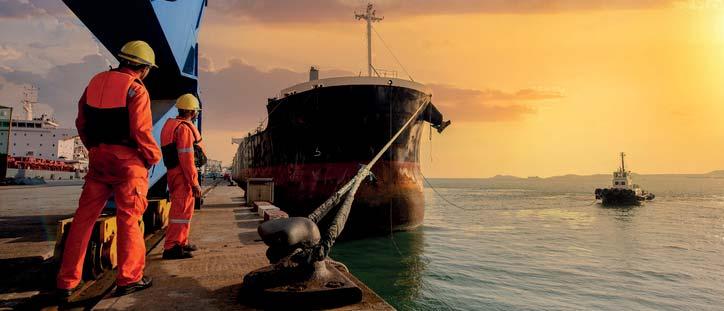
State-owned port authority Companhias Docas do Espirito Santo (Codesa, located in the state of Espirito Santo, north of Rio de Janeiro) went private in the first half of 2022 when Quadra
The California Transportation Commission (CTC) approved US$175 million in funding for the 7th Street Grade Separation East Project, which will realign and reconstruct a primary trucking and access gateway into the Port of Oakland. The project is expected to commence during 2023, with the Alameda County Transportation Commission managing the process, with financial and engineering support from the Port of Oakland.
Capital investment fund paid Reais106million (US$22.6 million) for a 35-year concession.
TechnipFMC, which has wide interests in Brazil, has signed a five-and-a-half-year contract to operate a facility in Vitoria to support its offshore activities.
Quadra says it will invest Reais850m over its concession period, covering infrastructure, equipment and various expansion
The European Sea Ports Organisation (ESPO) has confirmed that the Aqaba Container Terminal, Jordan has been awarded the EcoPorts’ environmental management standard (PERS) for the third time. Aqaba first joined the EcoPorts’ network in 2013 and its latest PERS-certified status again acknowledges the efforts of the port in conjunction with protecting the marine ecosystems of the Jordanian coast and the Gulf of Aqaba.
projects, and predicts throughput will jump from seven million to 14 million tons per annum.
“Our contract with TechnipFMC is a historical contract as it is the first private contract made within the scope of a private port authority,” said Ilson Hulle, President, Vitoria Port Authority. “It’s a small step but we hope it will be the first of many, especially in the growing oil and gas industries.”
AD Ports Group (ADP) has signed two new agreements with the governments of Kyrgyzstan and the Republic of Sudan. The Ministry of Economy and Commerce of Kyrgyzstan has secured more than 300,000m² of land within the Khalifa Economic Zone Abu Dhabi (KEZAD) to develop and operate a logistics hub and customs area. In Sudan, ADP (and Invictus Investment) is supporting the development of Abu Amama port.
The Jawaharlal Nehru Port Authority (JNPA) has agreed a 30-year contract with JM Baxi Ports and Logistics to develop, operate and maintain two terminals – a shallow water berth and the coastal berth which was developed in in 2020 and is designed to handle 2.80 million tonnes/yr. The shallow water berth when fully developed will offer an annual throughput capacity of four million tonnes and will posses a 445m quay line with 145m of this for ro-ro operations.
This project follows on from JM Baxi partnering with CMA CGM in the winning bid for acquisition of JNPCT – a 680m quay and 54ha yard container handling facility. The result of this PPP project was announced in mid-2022.
Cepsa – the Spain-based multinational oil and gas company – is to invest €3 billion to establish the Andalusia Green Hydrogen Valley, a development that is claimed to create Europe’s largest green hydrogen hub in southern Spain. The company will set up two plants, each with a total capacity of 1 GW of green hydrogen, with one located in Huelva, adjacent to Cepsa’s La Rabida Energy Park and the other at its San Roque Energy Park in Cadiz.
Nippon Yusen Kabushiki Kaisha (NYK) has undertaken a trial of SpaceX’s satellite service, Starlink, on one of its ships. SpaceX is an Elon Musk company and in July 2022 it announced its satellite connectivity service to the maritime industry as soon as it received authorisation from the US Federal Communications Commission. Starlink uses low-orbit satellites to offer faster communication feedback, whereas the traditional process for ship-to-shore links are reliant on high orbit satellites, thereby leading to slower speeds.
Qinzhou Automated Container Terminal, China, operated by Beibu Gulf Port, has successfully implemented OPUS Terminal and is now developing advanced features such as Artificial Intelligence (AI)based intelligent forecast and operations plans, designed to achieve higher productivity and lower cost operations across-the-board.
The Port of London Container Terminal, located at the port of Tilbury in the UK, has signed a new SaaS (Software-as-aService) agreement with Portchain Quay. This new arrangement, effective January 19, 2023, will see Portchain Quay create reliable berth plans in the port supported by intelligent predictions, thereby improving the planning process for both the terminal and its customers by providing digital, real-time updates to the terminal’s planners and more accurate berthing predictions.

The Port of Rotterdam is now using an integrated planning approach to manage inland container shipping and allied activities. After what it describes as a “rigorous test period” the Port Authority of Rotterdam has deployed Nextlogic to help ensure faster processing of inland vessels at ports and terminals in order to improve efficiencies and use of quay space.
For each inland vessel, barge operators submit port calls, rotation, and cargo information to Nextlogic in advance of the sailing and each cargo terminal provides the details for its available quay capacity.
Nextlogic then compares this data, optimises the planning schedule for vessel calls on an automatic and continuous basis, before then generating the best timetable for all parties involved.
Allard Castelein, CEO Port of Rotterdam Authority, notes: “Nextlogic’s integrated planning for inland container shipping is a perfect example of innovative digital chain cooperation. This cooperation enables us to create a better balance between the coast and the hinterland and establish a more balanced
logistics system. It makes the port of Rotterdam smarter, more sustainable and, therefore, more attractive for clients.”
Rotterdam has confirmed that approximately 60 per cent of its entire inland shipping volume is already covered via the Nextlogic system, with four deep-sea facilities and 15 different barge operators also participating. Additional deep-sea handling centres, empty container depots and more barge operators are expected to link to Nextlogic in the near future.
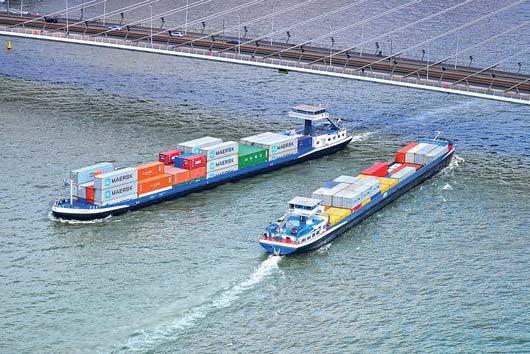
Sijbrand Pot, Interim Director of Nextlogic, endorsed the strategy
and highlighted the plans moving forward: “I’m delighted that barge operators, terminals, and we, as Nextlogic, have jointly managed to progress this integrated planning to a standard service. It is an important milestone in this port-wide innovation project. Together with all parties involved, the ultimate goal is to achieve a more transparent, efficient port that benefits everyone.”
The Maritime and Port Authority of Singapore (MPA) has signed an agreement that will see a 5G mobile network offered at the Port of Singapore.
MPA has agreed a Memorandum of Understanding (MOU) with Infocomm Media Development Authority (IMDA) for delivery of full maritime 5G coverage across all major anchorage points, terminals, fairways and boarding areas. Delivery is expected to be by mid-2025.
Quah Ley Hoon, Chief Executive, MPA, notes: “Digitalisation continues to shape and transform the maritime industry, acting as a key driver for global trends such as logistics, supply chain efficiency and decarbonisation. MPA is taking the lead to help build a robust digital maritime ecosystem for Maritime Singapore, with fast, secure and high capacity 5G connectivity as one of the cornerstones to support
New features have been confirmed by the Port of Los Angeles to its Port Optimizer portal. First launched in 2017, in collaboration with Wabtec Corporation, this dynamic cloud-based information portal specialises in digitalising maritime shipping data for the port’s supply chain stakeholders..
Now the port authority and Wabtec, in partnership with GeoStamp, is allowing users a single view that offers real-time and historical truck turn-times for all 12 container terminals in the San Pedro Bay port complex. In addition, for container terminals
The Port of Duisberg has created a sustainable solution that digitally records the identification of a container and then compares it with the loading list in just a few seconds, while maintaining a recognition rate of almost 100 per cent for the discharge and loading of vessels. Working with industrial image processing specialist, VITRONIC, highresolution 12K cameras have been successfully tested on two cranes in this German port.
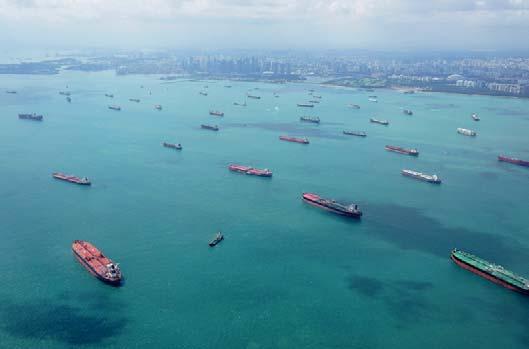
8 Maritime Singapore will soon see 5G coverage, the phasing in of the Integrated Port Operations C3 system and the launch of its Active Anchorage Management System
running through to 2026 as MPA upgrades its systems. It will enhance situational awareness and improve the efficiency and effectiveness of incident responses.
real-time data exchanges in the maritime domain.”
MPA has also confirmed the development of the Integrated Port Operations C3 (Command, Control and Communications)
system (IPOC system) in collaboration with the Defence Science and Technology Agency (DSTA). The IPOC system will be progressively phased into operation, starting in 2023 and
Singapore is additionally launching its Active Anchorage Management System (AAMS) in Q3 2023, which will utilise data to optimise allocation of limited anchorage space for vessels. The key benefit here is that it ensures that a vessel is anchored safely while taking into consideration various conditions including the wind, tide, depth and proximity to hazards.
in Los Angeles, the average dwell times for both trucks and on-dock rail are also an option.
“With these enhancements, the Port Optimizer will now provide visibility for 70 per cent of the import data for the San Pedro Bay port complex,” said Gene Seroka, Executive Director, Port of Los Angeles, adding: “Based on industry feedback, we have made additions that give stakeholders more planning and performance capabilities.”
Nalin Jain, President, Digital Electronics Business, Wabtec,
The Port of Ashdod, Israel, has confirmed the signing of new agreements with five start-up companies at an investment cost of around US$1 million. The move is part of the port’s technology incubator that has been established as it targets a new innovation strategy. Different companies supporting crane monitoring, port cameras and protection against cyber-attacks are all benefitting from the new spending.
outlined the tangible benefits to users: “Port Optimizer’s enhancements will help port stakeholders optimise their operations, relieve congestion stemming from increased global shipping traffic, and get products to people faster.”
The range of data available to users is now comprehensive. It includes a daily assessment of projected volumes due into Los Angeles up to three weeks in the future, while an estimate of the movement of containers by imports, exports and empties for
Zim Integrated Shipping Services Ltd is supporting a new platform for cross-border trade financing to support the activities of small-tomedium enterprises (SMEs). The product, being developed by 40Seas, is targeting ways of closing trade finance gaps by offering a solution that enables digital B2B payment functionality, as part of the cross-border trade process. Zim has provided 40Seas with US$11 in new million funding.
the next six months is also provided.
Historical containerised volumes by terminal, shipping line and vessel are given, along with current trends, while practical planning details of truck turn times, vessel discharge information in relation to remaining boxes on berths and when and where to return empty units are other key components.
The Port Authority of Gijón (PAG), Spain, has awarded a new contract to Prodevelop to digitalise its rail-port system in order to provide better monitoring and coordination of rail traffic at the port. This new solution will be integrated into the current port management platform at the port and will improve the exchange of information involving European rail freight services and cargo movements to/from the port.
Submissions are now open for the 44th Propulsion & Future Fuels Conference, the leading international conference on powering shipping’s emissioncutting ambitions. Present to a 150 strong maritime audience including operators representing


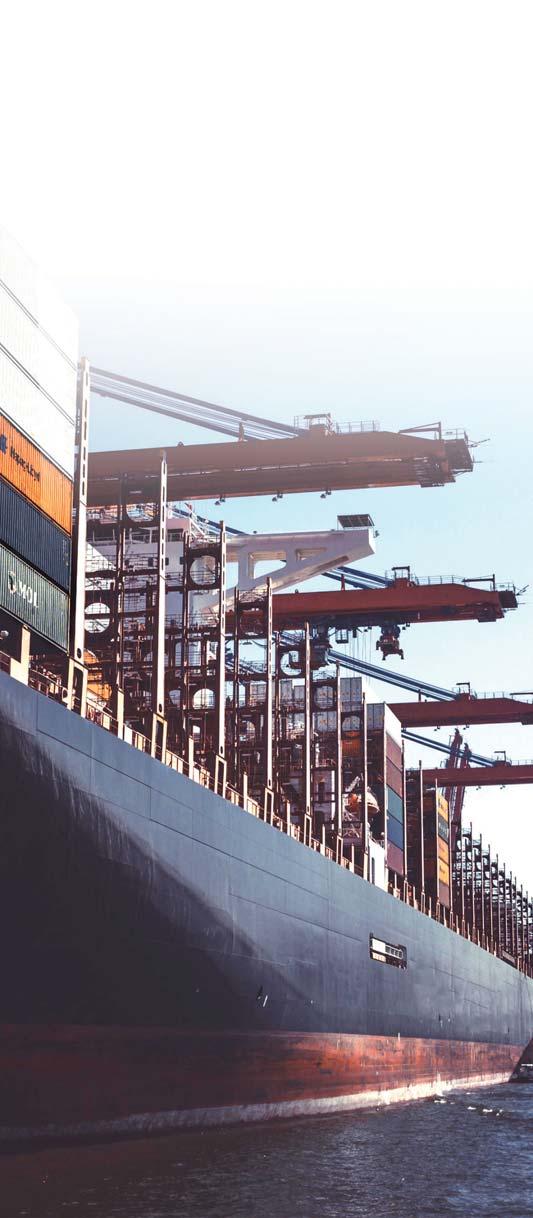
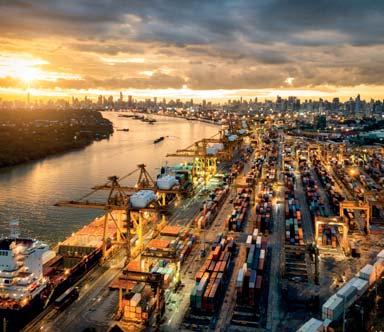
Abstracts of 250 words should be sent by February 24th, with a biography of the speaker, headshot photo and logo to conferences@ propulsionconference.com
Visit: motorship.com/PFFBOOK
Contact: +44 1329 825335
Email: conferences@propulsionconference.com
#MotorshipPFF

International Container Terminal Services, Inc. (ICTSI) has had two brand new ship-to-shore (STS) container cranes delivered to its South Pacific International Container Terminal (SPICT), located at the Port of Lae.
The significance of this investment is that it marks the first arrival of STS cranes in the region, while also representing the largest port machinery in Papua New Guinea (PNG) and therefore enabling larger container ships to be more efficiently handled.
The new Post-Panamax units will replace mobile harbour cranes and have been manufactured by Shanghai Zhenhua Heavy Industry Co. Ltd. (ZPMC) of China. Each crane offers
Robert Maxwell, CEO of ICTSI
South Pacific, confirmed the importance of the new cranes and noted that: “With improved
The Europa Container Terminal, Antwerp is to raise its annual capacity by 40 per cent by Q2 2025. Operator of the facility, PSA Antwerp, has signed an agreement with Stadsbader/ DSG for the first phase works, spanning civil and electrical infrastructure, designed to prepare the yard for the introduction of new automatic stacking cranes (ASCs).
Works will also be undertaken to accommodate new ship-toshore cranes as well as facilitate improved trucking flows.
The project represents a key part of the major overhaul of this facility by PSA Antwerp and the
Nokian Tyres, of Finland, has launched a new tyre for the front axles of reachstackers and other heavy duty cargo handling plant that is said to offer up to 35 per cent longer use. “Attention has been paid to the tire flexing area, which benefits from our special shock-absorbing rubber compound used in the tyre carcass. Thicker tyre results in longer service life,” explains Kimmo Kekki, Product Manager, Nokian Tyres.
Port of Antwerp-Bruges. It will also see a new, deeper, quay wall and generally greater automation and enhanced sustainability.
A contract has already been agreed with Austrian crane manufacturer Kuenz and the electrification and automation specialist ABB, for an order for 14 new ASCs. After delivery, the Europa Terminal will operate 48 units in its upgraded yard.
With the introduction of the end-load ASCs, all yard operations and truck handling will be done by ASCs. This will significantly increase capacity, which will largely be achieved by containers being stacked six high compared
Nidec ASI, part of the Energy & Infrastructure Division of the Nidec Group, has secured the tender for implementing a “shore-to-ship” electric power project for the Port of Sète, in the south of France. The €2.5 million contract is designed to facilitate compliance with EU directives that state European ports must adopt specific electrification systems for port quays by 2025 with the objective of decarbonisation in mind.
to the existing arrangement of just three high. It will also have the benefit of reducing total carbon emissions at the terminal by more than 50 per cent with each container handled.
Kuenz is designing and producing the ASCs, with ABB taking care of all matters relating to systems integration, for what represents PSA’s first order for end-load ASCs across its portfolio.
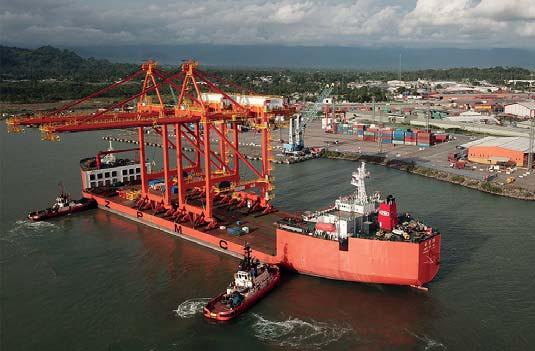
Parts for the first six cranes are scheduled for delivery in early 2024 and will be assembled on site, with testing then expected to start Q3 2024. The construction process of building the next eight units will commence in Q3 2024.
Maputo Port Development Company (MPDC), Mozambique, has placed an order with Kalmar, a Cargotec company, for 14 T2i terminal tractors and three forklift trucks, including two heavyduty units and one medium range model. Booked in Cargotec’s Q4 2022 order intake, all machines are scheduled to be delivered before the end of Q2 2023. MPDC has been using Kalmar equipment since 2008.
8 Ongoing investment by ICTSI at the Port of Lae, PNG has seen two STS gantry cranes arrive to offer greater efficiency in quayside handling and facilitate handling larger size vessels
productivity, the Port of Lae will soon become an important transshipment hub for the Pacific islands region.”
He added that as a result of this investment the port’s shipping line customers will see increases in quayside productivity and shorter port stays, while the ability to handle larger container ships will help to drive lower prices for both importers and exporters in the region.
“As we plant the seeds to create sustainable port cities and communities, it is our hope that this new equipment will further sustain Papua New Guinea’s economic growth and expanding international trade over the coming years,” Maxwell stated.
In order to ensure sufficient power supply is maintained for the new cranes, ICTSI South Pacific invested in two 2.5-Megawatt Cummins power generators in advance of the cranes arrival, although this is only part of the company’s investment plans which also include procurement of three new truck trailers for Lae as well as two rubber tyred gantries (RTGs) due for delivery in 2023.
Nassau Container Port (NCP), which undertakes container handling at the facility at Arawak Cay, Nassau, Bahamas, has placed an order for an eco-efficient Generation 6 Konecranes Gottwald Mobile Harbour Crane. The crane is slated for delivery in July 2023. NCP has also selected TRUCONNECT® remote monitoring that sends its data via a secure mobile connection to the Konecranes cloud service.
Join the world’s leading conference on balancing environmental challenges with economic demands
Host Port:
To help celebrate the 135th anniversary of the Port of Lisbon, GreenPort Congress and Cruise returns to showcase this vital and vibrant Atlantic gateway to Europe from 18-20 October.

Meet and network with over 200 attendees representing port authorities, terminal operators and shipping lines. For more information on attending, sponsoring or speaking, contact the events team: visit: greenport.com/congress
tel: +44 1329 825 335 email: congress@greenport.com
Sponsored by:
Media Partners: PORTSTRATEGY

Bothra Shipping Services has ordered three allelectric Generation 6 Konecranes Gottwald Mobile Harbour Cranes, with delivery scheduled for Q2 2023. The units are for the company’s bulk terminals at the Port of Kakinada, India, and offer a lift capacity of up to 125 tonnes and working radius of 51m. Bothra owns and operates an eight million tonnes per annum coal terminal and a six million tonnes per annum fertiliser facility.
The shore-based supply of electricity to power vessels when in port is steadily gaining traction – as recent developments indicate.
Leading global shipping line, CMA CGM has signed a long-term strategic collaboration with Shanghai International Port Group (SIPG) to develop, on a mass scale, the use of onshore power supply at the Port of Shanghai. The arrangement will see all CMA CGM ships, either constructed with the appropriate systems or retrofitted to take advantage of cold-ironing technology. By mid-2023, the partnership is expecting to see up to 50 vessels connecting at the port
The Port of Narvik and Norwegian company Plug Nord have secured funding of NOK 10.7
million (€1.02 million) to develop shore power for cruise ships. The plan is to build both a highvoltage facility for the larger cruise ships and a smaller low-voltage facility for smaller cruise vessels, although only one vessel at a time can be accommodated. Operations are planned by end 2024.
Elsewhere, Montrose Port Authority is partnering with Norway-based Plug Shore Power Ltd, in a 50/50 joint venture that will see the port become Scotland’s first facility able to provide shore power to offshore energy vessels. Dubbed Plug Montrose Ltd, the installation process will take up to 12 months to complete.
The Port of Québec, Canada is also now conducting a feasibility
8 Shored-based power is only available at two per cent of ports globally, but traction is growing, including at Shanghai

study for provision of shore power supply for cruise ships, following use, in 2022, of a greenhouse gas (GHG) rating tool from maritime risk management agency RightShip. The process assessed emissions from ships entering the port’s jurisdictional waters and facilitated the offer of discounts on port fees to vessels, dependent on their GHG rating and emission efficiency. However, the port is going one step further and moving towards shore-based power which is required as the Cruise Lines International Association has committed to all ships berthing at an electrified dock by 2035.
Liebherr Container Cranes Ltd. has completed its first ship to shore lift height increase using the company’s new patented jacking system.
The operation was completed at Patrick Terminals – Brisbane Autostrad, located on the east coast of Australia, as part of the crane manufacturer’s LiebherrTransform business package.
Although the actual lift height amendment has not been disclosed, Liebherr has said that
the operation was carried out on a crane supplied in 2015 that offered an existing lift height of 37.5m, but “with larger vessels calling at the port, a lift height extension was required.”
Although Liebherr has been carrying out lift height extensions for a number of years, this new jacking system was only patented in 2022, with the Brisbane terminal seeing its first use.
However, there is already another project confirmed. GCT
New York operates four Liebherr ship to shore container cranes. Supplied in 2004, these units have a lift height of 36.57 m and an outreach of 50m, but a LiebherrTransform project is going to upgrade the lift height of the cranes by 8.6m and the outreach of the cranes by 5.0m to facilitate the working of larger ships.
GCT New York is one of two facilities in the Port of New York/ New Jersey recently acquired by CMA CGM.
Hamburger Hafen und Logistik AG (HHLA) is commissioning the construction of a hydrogen filling station as part of the test centre for hydrogen powered port logistics at the Container Terminal Tollerort (CTT) in the Port of Hamburg. The facility is due to commence operations before the end of 2023 and will allow straddle carriers, forklift trucks, reach stackers and tractor units to be run on hydrogen throughout the terminal.
The Port of Valencia has confirmed its first load of hydrogen (H2) has arrived to supply its new refuelling station located on the Xità quay. This makes the Spanish port the first facility in Europe to offer a hydrogen installation in real operating conditions. The hydrogen supply station (HRS) can receive, store and deliver compressed hydrogen via dispenser to refuel port machinery. Prototype new handling equipment – a reach stacker and 4 x 4 tractor unit - that will use the station is set for delivery in the first quarter of 2023.
It is a new year, with a new Congress, and new sets of battles to be fought. Looking ahead, with my always cloudy and cracked crystal ball, I see that “supply chains” have smoothed out. Ports, perhaps, will be retreating from the media landscape - with pictures of anchored vessels making “top of the fold” front pages (web or print) and even network TV hiring harbour launches in order to bring the situation to their primetime newscasts.
The past three years were unprecedented - with 2020’s pandemic putting a damper on cargo flows, the overheated trade recovery in 2021 into early 2022, and the subsequent easing as things returned to “normal” (however you define it).
The Biden administration, whether you support it or oppose it (in my case- I stay mum), needs to congratulated for bringing “infrastructure” (the “I-word”) to the fore; something the previous administration talked about,
but failed to pull the trigger on. It goes without saying that seaports are central to the “I-word” and, for the coming year, I see new forms of cooperation between the ports and all manner of stakeholders - though the infrastructure development picture holds significant potential to look different from how it has historically.
In the maritime world, two big “D-words” have been digitalisation and decarbonization. We are in the
midst of a freight tech boom funded, in part, by private equity which was attracted at least partially by those aforementioned TV views of ships and boxes stacked up at drayage yards. At the same time, the push for ESG (Environmental, Social Governance) continues; my particular focus has been on
the “E” aspects - fuel saving and reduced emissions of carbon (and other substances, as well). Regulations concerning carbon intensity that are now beginning to impact international shipping will reward some players and penalise others. The new ratings for shipowners are influenced by trading patterns , things like the length of voyages, numbers of port calls - it’s inherently complicated. Of course, ship designs and naval architecture (efficient engines, smooth hull forms, etc.) will continue to evolve.
To a growing extent, the new regulations will drive the flows of cargo - and infrastructure investment for cargo (and for passengers). They will be influenced, more and more, by environmental considerations. With the increased ability to measure operational elements (to get a better measurement angle on actual emissions), planners will be operating with a much different canvas.
UNCTAD, in its yearly flagship publication, the review of Maritime Transport, has highlighted the considerable uncertainty facing shipping and ports. UNCTAD has developed four scenarios, based on key uncertainties in the geopolitical context and the COVID recovery.

Broadly, based on these four scenarios, we could see a sustained recovery of international trade, an interrupted recovery (either due to an intensifying war or due to the continued effects of COVID-19 as a result of high infection levels and new variants) or a ‘derailed’ recovery, if both of the above play out. In these scenarios, the uncertainties related to fighting climate

change, are not even included – though UNCTAD is very much aware of these.
The DNV Maritime Forecast for 2022 is focused on these uncertainties and counts 24 different ‘future fuel mix scenarios’ with huge differences in the shares of fuels such as LNG, biofuels, methanol and ammonia. In the 2022 publication, DNV focuses on this uncertainty and does not add uncertainties regarding trade volumes to the analysis - though it is very aware of these.
Both reports show ports and shipping are in a period of ‘deep uncertainty’ in which there is no clarity on the direction, speed and
interrelations between key drivers of change (like initiatives to curtail climate change, or geopolitical tensions) in the long-term. Decision-making on infrastructure systems is very difficult when faced with deep uncertainty. The ‘traditional approach’ of predicting and acting upon such a prediction is not effective. Instead there is a need to acknowledge uncertainty, focus on robustness of (investment) decisions in different scenarios and ‘monitor and adapt’ as external events unfold.
However, this is easier said than done, especially for port development projects, because
such projects generally are ‘contested projects’ in the sense that some stakeholders are highly in favour while other stakeholders are fiercely opposed. Given the deep uncertainty, the often advocated stakeholder involvement approach of seeking to create agreement regarding assumptions (like for instance demand growth or energy needs) is increasingly problematic. That may imply that contested projects can only be executed if stakeholders can reach an agreement on decisions (i.e. whether and how to expand a port and with which kind of policies to mitigate societal impacts).


2022 ended bleakly as the global economy headed towards a recession. 2023 does not look optimistic for the coming six months at least. Time to batten down the hatches.
As 2022 came to an end it became increasingly clear that the good old days were gone with the collapse of sea freight rates, cargo demand and the accompanying economic pressures that will ensure that the next six to nine months will not bring any renewed joy.
In the container industry, carriers are reverting to old practices of trying for market share to fill their ships which, in turn, puts further downward pressures on freight rates. Rather than facing the issue of the collapse of demand and putting ships into lay-up, the current preferred option is to blank sailings and let ships sit at anchor. A short-term solution to a longer-term problem. The bulk sectors, dry and liquid are also under pressure as commodity demand declines due to reductions in industrial production which results in less need for coal, steel, crude oil and
petroleum products. The exception is the LNG sector as Europe has changed from pipeline gas to imports by ship from further afield.
The biggest disruptor is the war in the Ukraine which has caused economic problems in Europe, North America and Africa. The rush to find alternative sources of oil and gas allowed producers to push up prices and require long term contracts which in turn pushes up inflation in the energy market even as spot prices decline. Inflation that
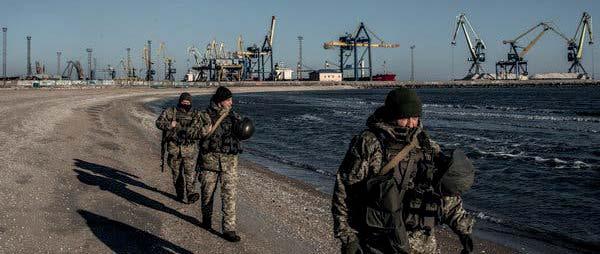

At Port Strategy we focus a lot on the larger port and terminal facilities – we are very mindful, however, that the larger ports and facilities in them are not the whole story. Smaller or secondary ports, whatever you prefer to call them, also make up a very interesting sector of the port world. There is nothing like a niche business and we would like to hear more about yours, if you have a story to tell.
What sort of story?
Essentially any subject that will prove of interest to your peers. How as a small port you identified and captured a new stream of
began with oil and gas has by now filtered into the foodstuffs and consumer markets as wholesalers, retailers and producers push up prices either to cover additional costs or simply for profits sake.
Inflation triggered rising interest rates across the globe as central banks had no other tools to reduce inflation, which of course hit demand as expected and there we come full circle. The IMF warns that fully one third of the global economies are in recession but if we consider
that this includes most of the major economies then it becomes more serious.
The U.S. narrowly avoided a “formal” recession in 2022 but can it hold on to growth as demand declines? Probably not. Europe is for all intents and purposes in recession. With the Ukraine conflict stretching into year two things can only get worse.
Definitely not a bright outlook for this year.
business and what were the drivers behind this? What advantages did you capitalise on that your larger competitors may not have been able to offer? What challenges do you face? Does a low cargo throughput present problems in generating sufficient funds for asset replacement –pilot boats, tugs, terminal hardware etc? Would you say that you are disadvantaged in terms of attracting and retaining quality staff or do you consider your organisation is in the opposite position? Is it a struggle to implement tariff increases due to
a limited client base? What progress have you made on the road to decarbonisation – is this challenging? Do you have investment opportunities, what are they?
During Covid, in Europe and elsewhere, we saw a lot of secondary ports provide solutions to congestion problems in particular. This was a coming of age that provided an opportunity for a number of smaller ports to show what they can do and frequently with good results ensuing. So, what happens now? Do things go back the way they
were or can certain business streams be retained?
We ask these questions against a background of recognising the inherent assets of many smaller ports and facilities – less congestion, the ability to be more cost effective, offer a personalised service, move freight quickly and present great flexibility.
In this column and elsewhere in PS we would like to hear more about the world of smaller or secondary ports – don’t hesitate to get in touch. mike@ mikemundyassociates.co.uk
The final conference of the iTerminals4.0, drawing on case studies, highlighted that a standard digital language employed in terminal operations can deliver significant benefits.
Felicity Landon reports
8 The standards of TIC4.0 work and via a common language offer significant potential to achieve new levels of efficiency – Malta Freeport identified data visualisation as a huge breakthrough
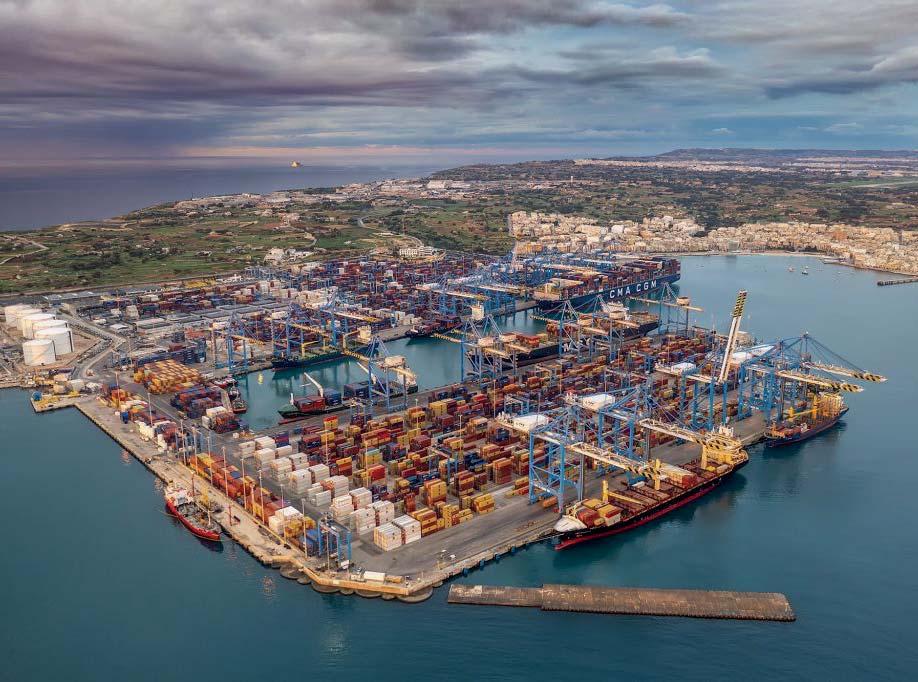
The main objective of the iTerminals4.0 project was to develop and test – in real operations – a standard digital language that allows for two-way communication between port equipment and the operations management systems of container terminals participating in the project.
While it would be easy to get entangled in the technicalities, the message that emerged loud and clear from the project’s final conference was that of tangible results in real places. Case studies were presented by Terminal Link’s Malta Freeport and Thessaloniki container terminal and by PSA Antwerp, with the focus on the application of standardised equipment telemetry and digitalisation of port terminal operations.
The overall project, co-funded by the Connecting Europe Facility (CEF), provided the opportunity to demonstrate that the standards of TIC4.0 work and are useful as expected, said Boris Wenzel, Chairman of Terminal Industry Committee (TIC) 4.0. “The iTerminals project demonstrated that TIC4.0 is not just theory, but it actually works,” he underlined.
Francisco Blanquer, Senior Innovation and Development Senior Manager at Terminal Link (CMA CGM), said: “Thanks to iTerminals4.0, we were able to really move forward with standards with a very high speed.”
He noted that operational processes in the container terminal sector can be very inefficient. “Capex has to be kept
low because the time the equipment is working is really low. We don’t have a continuous process where we are operating 24/7 – we only work when we have cargo. And even when the machine is working, it is also idling, so the percentage [of utilisation] is very low. How do you improve this number?”
The options to optimise equipment utilisation included a disruptive new process and automation, or the use of data to optimise the process, he said.
“It is not easy to get data – in the past we have failed, using only a small percentage of data. The reality is that it could be machine, process, person, terminal; whatever the process you want to express, it is complex, with a lot of actions happening every millisecond.”
Meanwhile, information about what happens ‘between events’ has been missing. “We need the high-resolution data between events – now, thanks to the data, we can do this. We can have the events and the time in between.”
Why is this important? The main goal is to represent the reality, which means being able, via an IoT and Big Data platform, to compare TOS events and the status of every single process with CHE (Container Handling Equipment) reality, said Blanquer. “You can detect when something doesn’t go as it should; you can compare ‘What should be versus What it is’.”
For example, he said, you could pinpoint when a terminal
tractor should be going to the yard to collect a container, but in reality it is idling. “Thanks to the IoT and Big Data, we can identify non-conformities in the last week, month or year.”
However, he emphasised, this is dependent on a language which can represent any reality – present, past or future, performed, actual or scheduled, planned, requested, proposed or estimated.
The iTerminals4.0 project showed that TIC4.0 ‘can express any reality in a digital format’, including subject, concept, observed property, point of measurement and value.
MALTA FREEPORT: A CLEAR PICTURE
“In theory, there is no difference between practice and theory – but as all of us know, in reality there is,” said Angel Martinez, Head of Projects, Maritime and Terminal Solutions at Prodevelop.
He outlined the project in which numerous IoT devices were installed in the Malta Freeport yard to give a clear picture of what was happening in the terminal, pinpointing idling and providing a live view tool for process improvement and data analysis.
Hein Chetcuti, Operations Development Manager at Malta Freeport Terminals, said: “There is quite a learning curve and learning process for us to absorb this information and these technologies and start using them at a technical level. After all the infrastructure, which was a huge challenge, we sat down and started to digest all the wealth of information that was presented to us from the Big Data platform.”
Data visualisation gives you the power, a different perspective, he said. He described the pilot project at Malta, a system demonstrating in real time all the operations and all the assets that are working together on one screen, as a huge breakthrough that could not be done before with other technologies.
“Then we started looking at how to add operational value to this information and we started with horizontal transport –terminal tractors manually driven. We wanted to understand where the weak points of operations are.”
Data can be used to detect anomalies; in this instance, human supervisors might have a feeling there were deviations but it was difficult for them to understand the reasons for this and/or visualise what was going on, said Chetcuti.
“With the strength of all this data, we can also try to understand a number of operational issues we used to have, for example, drivers driving too slow, stopping in areas where they shouldn’t be stopping, taking wrong directions.”
He concluded: “For us, this is only the tip of the iceberg. You start deploying the technology and when you start using it in the mainstream process, there is no going back, only the way forward.”
Terminal Link and RBS (Realtime Business Solutions) worked together to develop a pilot supporting the project, with digital twin/3D visualisation.
The PSA Antwerp project focused on application of TIC4.0 standards for telemetry data exchange with yard operations equipment – in this case, straddle carriers.

Dany Akkary, Digital Transformation Manager at the PSA Antwerp container terminal, said: “This was like an opportunity to take a leap into the future and apply a new industry standard. We found that data is key and that standardisation is crucial. Standards such as 4.0 unlock actionable data with ease.”
One of the biggest challenges continues to be harnessing and processing data, said Akkary. At Antwerp, straddle carriers were chosen for testing software, with initial datasets
such as spreader hoist and power source monitored. This was later expanded to include other datasets, to cover operational efficiency, safety and maintenance. The platform allows real-time information on equipment status, he said.
The iTerminals4.0 project at Thessaloniki focused on the application of TIC4.0 standards for operational interoperability with the TOS. The terminal worked with software specialist TBA (Konecranes). The data value chain starts with collection, moving on to development and usage – but it cannot be utilised without proper data management, said Ida Lundmark, Business Line Director at TBA. “There is a need for a digital platform that uses standardised messages. In this iTerminal4.0 project, we demonstrated the value of data.”
In a round table discussion, the question was asked: what lessons have you learned from the pilots?
From PSA Antwerp’s point of view, there was the huge security operation required. Patrick Snelders, Enterprise Architect at PSA Antwerp, noted that data has value, so it matters who can make connections to which devices. “That is something in general in the industry – you have the Internet of Things and throwing it to the Cloud is one idea, but that is something my company will never do. So, we have to think further – to have it in a private environment to collect all that data.”
Francisco Blanquer highlighted the need for data quality: “A lot of the data from the TOS was wrong and no one realised until we did the analysis. You think everything is running fine – and absolutely not. And when the data is wrong, automatic decisions are also wrong,” he said.
While it was hard to discover that some data quality was a ‘disaster’, it was also positive in that the situation could be improved, said Blanquer. But there was also the potential for conflict; if the data informs you that your equipment is idling 60 per cent of the time when you thought it was doing a fantastic job, it is hard to tell a super professional operator the reality.
8 The PSA Antwerp project focused on application of TIC4.0 standards for telemetry data exchange with straddle carriers
Bruce Mills, Business Development Lead, Ports, Wärtsilä, highlights how overcoming digital fragmentation can optimise vessel arrivals and raise the bar across a broad spectrum of port activities
8 Tanger-Med confirms diverse benefits flowing from adopting Wärtsilä’s PMIS solution, which incorporates Vessel Traffic Services and JIT solutions, alongside business intelligence and data analytics tools
Ports are complex parts of the supply chain. Caught between the requirement to remain commercially successful in a competitive market and implement all the latest rules and regulations, whilst maintaining the safety and security of some of the world’s largest man-made objects, these hubs are the key interfaces between land and sea trade.
Despite the monumental role they play in the global supply chain, some of the world’s most advanced ports still rely on systems that were implemented in the 1990s and continue to run traditional, manual processes – both of which are no longer fit for purpose to tackle today’s challenges.
A number of global events over recent years – the challenges of the pandemic, the Ukraine conflict and the Ever Given grounding in the Suez Canal – have all contributed to major disruptions in the global supply chain and severely impacted port operations. This has caused ports around the world to strategically rethink how technology can be used to mitigate the consequences of such events and also improve port operations when not in times of crisis.
Many senior managers are now reflecting on how digital transformation can help them improve safety, reduce emissions, and increase efficiency, competitiveness and resilience. Technology can be used to break down ‘silos’ and ensure the supply chain can communicate more efficiently, as all stakeholders are operating from the same data. However, it is important that any solutions deployed are holistic and interoperable to avoid creating a fragmented digital ecosystem, which can lead to duplication and inefficiencies.
Ports are part of the maritime industry’s increasingly complex digital ecosystem. There is a plethora of solutions out there and a lack of standardisation, meaning different stakeholders
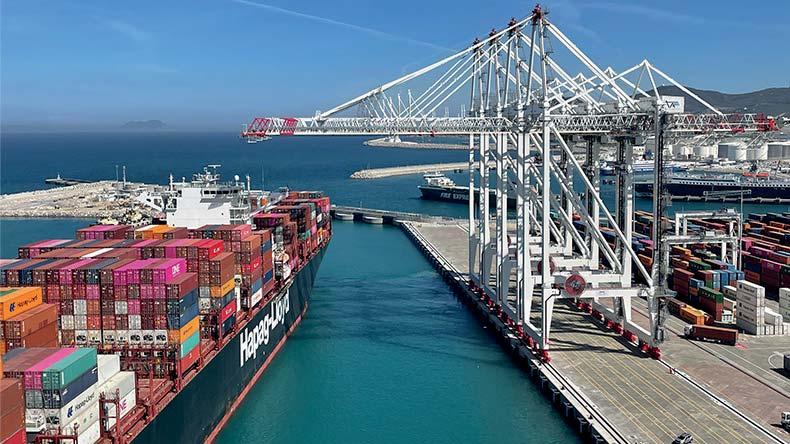
across the supply chain could each be using a different product – many of which are not interoperable or capable of sharing relevant voyage data with each other. Ports then attempt to overcome this fragmentation through costly manual processing, which is open to human error and often results in duplicated, incorrect or incomplete data being shared.
Data must be seen as a strategic asset and key component of port digitisation, so that all actors in the supply chain benefit from information sharing. Investing in a holistic data and digitalisation strategy is key, as is harnessing digital solutions that can be integrated across the entire port ecosystem.
With dismantled data silos, if a vessel is set to be delayed for any reason, information can be shared with the port at which the ship is set to dock and changes can be made to ensure everything is ready for the vessel to be loaded or unloaded at the right time.
Taking a holistic approach can be transformational from a supply chain perspective. With greater supply chain connectivity and data-sharing comes the potential for JustIn-Time (JIT) operations and the associated benefits. So, what are the benefits to JIT arrivals?
Looking at the maritime industry as a whole, saving fuel is critical to achieving emission reduction targets. Fuel consumption is the biggest contributor to the maritime industry’s 940 million tonnes of annual CO2 emissions. Therefore, anything ports can do to improve fuel efficiency is hugely valuable to the wider maritime supply chain. A study conducted by MarineTraffic and Energy and Environmental Research Associates (EERA) found JIT arrivals can lower fuel
consumption and carbon dioxide emissions by 14 per cent in conjunction with every journey. In turn, port workers and coastal residents benefit from these reduced local emissions and better air quality overall.
Looking beyond carbon to costs, the Wärtsilä team has identified that fuel comprises 43 per cent of total voyage costs and about 40 percent of a ship’s annual operating expenditure (OPEX). Therefore, ports that work with ship operators on JIT arrivals and help them improve the efficiency of their operations will certainly see more business and benefit from an improved reputation.
JIT arrivals can also reduce congestion and delays in ports – improving the safety, competitiveness and resilience of maritime operations. Congestion and confusion in busy port areas can significantly increase the risk of collisions; so clearly and effectively planning port calls ensures that both workers and valuable port assets are protected.
Increased efficiency and punctuality underpins competitiveness, not only compared to other ports, but also compared to other forms of transport such as air freight –which has been known to take business from ports in highly congested periods. In times when resilient and punctual supply chains are challenging to achieve, yet as important as ever, trying to achieve consistent JIT arrivals is a ‘no brainer.’
While the concept of JIT arrivals has been around for decades, the reality is that they have not yet been consistently achieved across the maritime industry and there has been no established procedure to share the benefits of JIT operations among all the stakeholders involved in a voyage – until now.
From the ports’ perspective, an advanced Port Management Information System (PMIS) is a key piece of the optimisation puzzle. It is used for planning, managing, monitoring and reporting all operations and related business processes. It is fundamentally a single source of information and data that can be made available, with the necessary security permissions, to any of the port’s stakeholders – whether internal staff, other organisations or even service providers (such as tugboat operators and marine pilots) and their customers.
autonomy, it’s important to remember that it enhances people’s roles and augments their day-to-day work. It can provide support with laborious and repetitive tasks to free up staff to focus on more complex challenges.
Digitalisation will expand further to support autonomy with those who adopt PMIS and enable JIT arrivals today, establishing the foundations for even more impactful future technologies. While the benefits ports are currently gaining from AI, machine learning and effective data use are substantial, this is only the tip of the digital iceberg.

In the future, a smart port’s systems could proactively and pre-emptively identify collision risks and prevent ships from getting into such situations, enhancing safety standards even further. Using the anticipated advancements in AI, machine learning, data and even more ground-breaking technologies, smart ports will be able to manage all of their resources optimally, making true efficiency and resilience a reality across their operations and for the wider supply chain.
To summarise, the digital journey is already underway at sea and onshore, and it can bring about much coveted safety improvements, efficient operations and enhanced resilience. To achieve this, it is critical that digital solutions are holistic and that data silos are broken down. When interoperable
and that data silos are broken down When solutions, such as advanced PMIS, are used, ports – and the maritime industry more broadly – remain ahead of the curve and ready to embrace supply chain modernisation with operations that are future-proofed and underpinned by data
Take TangerMed port in Morocco, for example. It is the largest port in Africa in terms of containerised cargo transiting through its facilities. It shares many of the same challenges as any modern port, but in addition it had lots of legacy solutions that wouldn’t talk to each other. In 2018 the owners of TangerMed set the Board of Directors the goal of becoming one of the top 10 most efficient ports in the world.
To achieve this, they adopted Wärtsilä’s PMIS solution, which incorporates Vessel Traffic Services and JIT solutions, alongside business intelligence and data analytics tools. As a result, TangerMed Port Authority succeeded in its goal earlier this year and was ranked sixth in a key global container port performance index.
The future of optimised port operations involves the uptake of more autonomous functions, which promises even greater supply chain safety and efficiency. When talking about
tion and It is can s, to ther boat the ting ges acy ners ming tion, ons, As a rlier take ater bout
8 Bruce Mills, Business Development Lead, Ports, Wärtsilä: “it is important that digital solutions deployed are holistic and interoperable”

While the benefits ports are currently gaining from AI, machine learning and effective data use are substantial, this is only the tip of the digital iceberg8 Digital fragmentation is the biggest obstacle to digital transformation
Shipping profits are being squeezed and the outlook is grim. This will have a far-reaching impact on the terminal sector. Andrew Penfold forecasts what happens next
8 The boom years are over with diverse shipping lines now owning much enlarged terminal portfolios –will they be able to sustain this position in the more difficult times ahead?
Following the Covid-led supply chain chaos of 2021 and 2022, container freight rates have collapsed and are pretty much at the same level as they reached in 2019. At the beginning of the year Drewry’s World Container Index was running at a level of around US$2,100 per 40’ container. At the peak of the market in January 2022 the corresponding rate was around US$9,700. The pattern of decline spread across the market, but the sharpest proportional drops were noted on the key Transpacific and Asia to Europe trades. This trend was also reflected in the other key indicator – the Shanghai Containerized Freight Index.
The massive profits recorded by the lines over the period represent a one-off gain. The ripples of this will spread out across the port market.
The resulting windfall profits have distorted the market and the impact has yet to be fully realised. The responses of the lines to these unprecedented profits have been interesting and will have far reaching effects on the port and terminal sector. Their responses have focused either on rapid expansion of capacity by means of a surge in newbuildings or an upturn in the pace of related infrastructure and other supply line supporting investments.
The former seems likely to have far-reaching negative impacts, whilst the latter will shift the structure of the market. Both responses will impact sharply on the port sector.

The orderbook for cellular container vessels is now very high and, according to Maersk Broker stands at over 30 per cent of existing fleet capacity. This is a higher proportion than noted in the late 2000s when the first round of the size-based revolution in the sector was in full swing. This ordering is concentrated on the largest vessel classes, with around 2.9m TEU of capacity in the 15,000TEU+ size range slated to be
delivered by 2025. Even with some cancellations and delays it looks like a case of ‘déjà vu all over again’.
Even with optimistic trade forecasts it seems certain that this capacity can’t be absorbed – and certainly not on the major east-west trades. Also, such optimism is thin on the ground. Despite some recovery in 2021, total container trade volumes remain marginally below 2019 totals and this weakness is most focused on the headhaul transpacific eastbound and westbound Asian to Europe trades. The world is currently heading into recession, with the World Bank reducing its global growth forecasts for 2023 from 3 per cent to 1.7 per cent in early January. The outlook for Europe is particularly poor, with most risks clearly on the downside.
So, we have a massive increase in supply and – at best – a stagnation in demand. The implications are clear, the shipping lines face a collapse in rates and profitability. The collapse in rates is well underway and the natural follow-on from this is a significant downturn in profitability. Short term moves to manage capacity – blank sailings, slow-steaming and rerouting – will not solve the problem.
The other approach to the windfall results of 2021 and 2022 has been to invest downstream in supporting infrastructure. This seems a more sensible strategy but will also cause some upheavals. Recent examples include MSC subsidiary TIL’s acquisition of Bolloré Africa Logistics, CMA CGM’s investment in the GCT terminals in New York and Evergreen’s completion of its 100 per cent stake in Colon Container Terminal. The logic of these purchases is clear: the integration of suppliers into the core shipping business. This has been a long-term trend, but it has accelerated sharply in the past two years with the sudden availability of cash.
The acceleration in this activity has also seen a new twist to it – the willingness on the part of key lines to bid very high numbers to secure terminal assets. The underlying thinking
is that the terminal asset can be leveraged to generate greater volume for the core shipping business and allied other services as well. A good case in point is the recent 30year concession for Jawaharlal Nehru Port Container Terminal, won by CMA CGM’s subsidiary CMA Terminals in partnership with J M Baxi Ports & Logistics with both parties taking a 50 per cent stake. Taking control of this facility, now known as Nhava Sheva Freeport Terminal, is integral to CMA CGM’s core stated objective of consolidating its end-to-end service offering and establishing greater control over the logistics chain to offer its customers “…higher quality, integrated, digital and more environmentally friendly services in a context that requires a comprehensive approach to the supply chain.”
It will be interesting to see if this approach – in a highly competitive climate - is one that ultimately pays off?
Quantifying the level of future freight rates and liner profitability is always very difficult but past experience shows that the link between supply and demand cannot be overcome. The container shipping market is heading for the rocks and there is little that can be done to steer away. Freight rates will fall to levels seen in the period 2016 to 2018, orders will be delayed, and scrapping will accelerate. Its also possible that lay-up of modern tonnage may be enforced.

Demand seems certain to remain weak in western Europe, although the outlook for the USA is somewhat more positive. With political and macro-economic uncertainties running high and the conflict in the Ukraine and Covid ongoing, it is unlikely that demand will remain stable this year and in 2024 and there are considerable downside risks.
Faced with these conditions the following pressures will be manifested on the port and terminal sector:
5 There will be pressures to deploy very large vessels onto secondary trades for which they were not really designed. The ‘cascading’ process that has been a feature of the container market can only continue and accelerate. The limitation here will be the capacities of container terminals in the secondary ports in Latin America, Africa, Australasia and the Indian sub-continent. The issue will not just be one of draught. In diverse cases, vessels will be lightly loaded – but with handling longer vessels at the berth, turning circles and the availability of gantries with sufficient outreach there will be challenges. Managing these requirements will require investment and, as has been mentioned, investments from lines in the anticipated market will be scarce.
5 There will be renewed downward pressure on stevedoring pricing. With lines increasingly focused on protecting profitability (or minimising losses?) all suppliers will come under pressure to ‘contribute’. In previous market cycles common-user terminal operators have been able to resist these pressures as often there were limited alternative deepwater facilities available. This position has changed. As has been noted in northern Europe most major ports have been able to handle the largest vessels and some port switching was possible during the congestion period. These lessons will not be quickly unlearnt.
5 The competitive nexus between line-owned and commonuser terminals will also be changed. Major shipping lines have increasingly focused on the provision of equity based dedicated capacity in major ports. The motive was initially to benefit from some of the perceived profitability in this sector with line-owned terminals seeking to market to third party
customers. This was a largely unsuccessful effort. With lines under pressure the motive for focusing operations at owned/controlled terminals will intensify. This will place pressure on the common-user sector where there is direct competition between the two types of operation. This is not a healthy situation – even in the short term.
The container business has always been cyclical and managing peaks and troughs has been key to survival. The current outlook is pretty bad with the classic solution to this – demand growth – looking more uncertain on the current cycle. What is clear is that once the current difficulties are negotiated there is still a long way for containerisation to progress in global volume terms.
Some reshoring will be recorded, and the role of China may be reduced over time as alternative low-cost
manufacturers come forward. These trends will continue to require heavy port investment in both new and established locations. With shipping lines under severe financial pressures and terminal operating companies also facing short term constraints. The seeds of change are here which promise to foster a change of emphasis in investment patterns plus there is the promise of opportunities emerging. History records that when the going gets tough lines dispose of terminal assets – is there any real reason to believe this won’t happen again?
An initial focus could be on partial investment into terminals owned by lines – perhaps on a distressed basis.
As interest rates rise, pressure will increase. This would offer an initial route into the sector for new capital to enter the market. Container terminals offer much higher potential returns for deep pocketed infrastructure funds than other sectors. Will the fallout from the short-term problems change the structure of terminal investment? Such a situation seems much more likely this time around.
seems much more likely this time around
Barry Parker takes a comprehensive look at green corridors – thinking on definitions, routes to implementation and the obstacles to overcome
8 Key elements to establish a green corridor – there is diverse thinking on corridor definition and the approach to implementation
At the recent COP27 event held at Sharm el-Sheikh, Egypt there was a great deal of buzz surrounding “Green Corridors”, a concept hatched 13 months earlier, at the COP26 conference, hosted in Glasgow. At COP26, nineteen nations signed on to the “Clydebank Declaration”- where they made commitments to “facilitate the establishment of partnerships, with participation from ports, liner operators and others along the value chain in order to accelerate the decarbonisation of the shipping sector and its fuel supply through green shipping corridor projects.” The objective set was a target of six such projects by 2025, and an “aspiration to see many more corridors in operation by 2030.”
Essentially the idea is based on establishing discrete trade routes where the vessel fuels, the port infrastructure supporting the cargo and fueling operations (along with the cargo production and consumption) are all “green”.
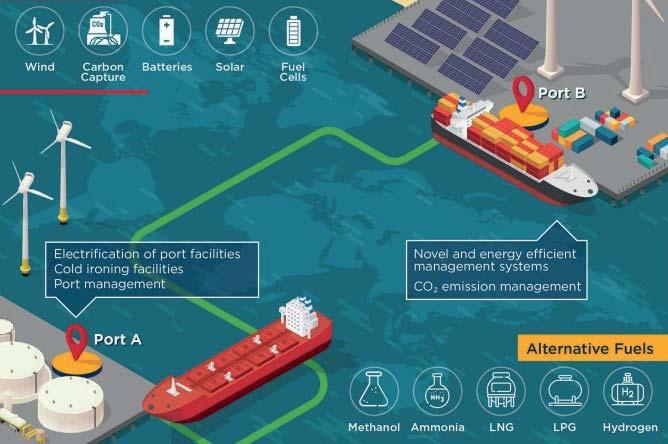
The challenges involved in creating lower carbon, or completely carbon free pathways for shipping trade are daunting; consider that shipowners, cargo providers, fuel producers and sellers, as well as regulators must also climb aboard. Ports are integral because of their geographical positioning at the opposite ends of disparate corridors. Over time, though, ports could evolve into fulcrums and network connectors, if many more corridors emerge – as envisioned by those who signed on at COP26.
Fast forward to the World Leaders Summit at COP27, in November 2022, which featured a proclamation from the U.S. Department of State that the U.S., in conjunction with Norway, was organising the “Green Shipping Challenge”. Projects mentioned, as this initiative was inaugurated, included,
among others: Australia-Singapore cooperation on green shipping corridors, Gulf of Mexico green shipping corridor, Los Angeles-Shanghai Green Shipping Corridor partnership and implementation plan, and Alaska British Columbia Washington Green Cruise Corridor.
Besides these inchoate efforts on the U.S. diplomatic radar, there have been numerous other expressions of intent to set up corridors. Most recently, U.S. and Canadian maritime authorities were outlining a corridor within the Great Lakes, linking multiple ports.
Interestingly, though the Clydebank signatories attempted to lay out the parameters of what, exactly, constitutes a corridor, there is no precise formula.
To grapple with the Green Corridors concept, and to get port planners thinking about how their participation might be framed, this article looks at several efforts to provide definitions, and to map out plans for how stakeholders might begin their implementations of new corridors. Besides the other issues of shipping decarbonisation (looking at vessel’s kit, and fuel types), seaports are central, in every approach.
The Maersk McKinney Moller Center for Zero Carbon Shipping (MMM), has issued several publications on the subject, working with the Global Maritime Forum (GMF) and consultancy McKinsey. The GMF, in its own discussion paper, “Green Corridors: Definitions and Approaches” puts the “PortCentric” approach at the top of its list in defining the pathways.
In detailing the nuts and bolts, the authors note that ports will look at: “…decisions about which activities will be greened,
with decisions about system boundaries, relevant cargo and voyages and even prioritised technologies likely to follow from the ports’ priorities.” In their discussion of one corridor, a liner shipping route between Shanghai and Los Angeles, they write that the corridor’s blueprint: “…sets the system boundary at the port gate, so that port operations, cargohandling, etc. are in scope. The importance of air quality issues and local community and environmental interests in both port cities are likely to have an influence on prioritysetting and fuel choices.”
Ports are also prominent in the GMF’s suggested steps for establishing corridors. GMF says, “Port readiness assessments – both the International Association of Ports and Harbors (IAPH), and the US government (within the Zero-Emission Shipping Mission) have advanced the notion of ‘port readiness’ assessments as an input to determining which Green Corridors might be feasible. These may assess operational readiness (IAPH) related to issues such as safe handling of new fuels, or they may attempt to determine the potential to develop suitable bunkering infrastructure based on potential for energy supplies, available land or infrastructure that can be repurposed (US/ZESM suggestion).”
The MMM/McKinsey publication, described as a blueprint for a phased implementation approach, highlights the important role of “Port Logistics and Bunkering”. It points to the need to estimate the demand for specific (alternative) fuels, and then to carefully investigate the feasibility of fuel storage and infrastructure early on – including regulatory and financial parameters.
The American Bureau of Shipping (ABS), a leading Classification Society, has issued a report “Green Corridors: Leveraging Synergies”, which presents very similar ideas, noting that: “The ports and fuel producers need to come together to detail the green corridor’s storage and bunkering demand profile based on vessel type, voyage and fuel characteristics. Ports need to focus on the storage requirements based on the fuel volume and the physical state of the fuel.” ABS adds that: “They will need to map the current and expected storage and bunkering ports/regions and their infrastructure capacity, and understand the regulatory requirements for handling alternative fuels, permitting processes and safety standards.” The ABS report also discusses the requisite analytics, keeping in mind questions of whether cargo moves will stimulate demand for the new fuels, or, perhaps, vice versa. Importantly, ABS conducts an analysis of port readiness for more than a dozen ports that are likely to be endpoints of corridors (or perhaps the nexus of a bigger seascape).
Though the Clydebank drafters envisioned a mere handful of corridors in coming years, others are already girding for the dozens (or perhaps hundreds) that might coalesce. The Zero Emission Shipping Mission (ZESM) a coalition of countries led by the United States, Denmark and Norway - and also tied to the GMF and MMF) with the stated aim of providing commercially viable alternative fuels by 2030, has created “The Green Shipping Corridors Hub” – an online toolkit centered around an interactive “Matchmaker” which “…enables stakeholders interested in developing green shipping corridors globally to find collaborators across the maritime/ energy value chain.” The hub also includes an interactive mapping application tracking announced initiatives, as well as an online repository of relevant “major analyses, frameworks, guides and assessments” on the subject.
The hub, launched at COP27, comes out of work on the Blueprint for Future Ports Program, which, in turn, was launched by the ZESM, in September 2022 at the Global Clean Energy Action Forum, held in Pittsburgh (U.S.). Ports are
prominent players in ZESM’s “Action Plan,” published at this time, not surprisingly, as “fuelling infrastructure” is one of three pillars supporting its objectives. Consider item “D98” in the action plan – which lists the action “Create new business and operating models for ports” – without providing further details.
None of the architects cited here envision totally clear sailing. The GMF authors identify several issues that port-led initiatives will likely encounter; these are anti-trust questions (is “cooperation” legally appropriate?), unilateral versus bilateral cost sharing arrangements (who pays?), and, perhaps the most vexing, issues concerning data sharing. The GMF says that: “Governments will have an especially important role in enabling this framework, though transparency requirements on government agencies may hinder them from acting as the actual brokers of the data,” and goes on to suggest that innovative, industry-led, data sharing programmes may be the way to proceed.
MMM/McKinsey expresses concern that: “Stakeholder engagement may be more complex for network and point-to-point corridors as it can involve more port authorities and governments and span different countries and continents.”
September 2022 also saw a GMF Global Summit, held along the waterfront in New York; two months later GMF issued a summary of this three day meeting, which included a session focused on maritime finance. The authors note that: “Participants suggested that Green Corridors would imply a new ownership model, with green shipping services provided in a utility model, underwritten by long-term contracts and government guarantees.” Additionally, they talked about a risk sharing model for Green Corridors, saying: “The group discussing how to support first movers emphasised the operational expenditures associated with Green Corridors –i.e., fuel costs. Given the high costs associated with zeroemission fuels in the first years of these corridors, both public and private support were deemed necessary.” In their thinking, the public sector, where ports generally fall, would backstop whatever decarbonisation solutions are devised.
The MMM/McKinsey approach hints at an integral aspect of the corridors - that of fuels. Facilities for providing clean energy to vessels are, not surprisingly, closely intertwined with the corridors. “Clean Energy Marine Hubs” were the subject of a joint project that the IAPH launched along with the International Chamber of Shipping and the Clean Energy Maritime Taskforce at the Pittsburgh conference, in early October 2022. A few weeks later, in a keynote speech at the SHIPPINGInsight 2022 conference, in Stamford, Ct. USA, ABS Chair Chris Wiernicki talked about fuel hubs in the same breath as the green corridors, implicitly suggesting that one goes with the other.
Just as there are no precise definitions of what the Green Corridors are, there is not one clear-cut way to implement the concept.
Stakeholder engagement may be more complex for network and point-to-point corridors as it can involve more port authorities and governments and span different countries and continents
‘‘
8 Minimum political interference has benefitted Santos in recent times but now concerns are being raised that under a new political regime this may resurface
The change of government in Brazil will almost certainly lead to the cancellation of the plan to privatize the Santos Port Authority (SPA), but the tender to create a new container terminal in the port, STS 10, will go ahead in one form or another. However, fears of a return to “political interference” are widespread.

This is the view of several reliable sources in South America’s largest port, which has successfully increased volumes and profitability in recent years (see following article), but is now suffering capacity issues across several cargo categories, but especially on the container front.
Fernando Biral, the current president of SPA who is set to hand over the reins of power to a new incumbent in January, told Port Strategy that since his time on the board of SPA –initially as Chief Finance Officer, from March 2019, and then President from April, 2020 – the backing of Taricisio de Freitas, the then Minister of Infrastructure (and since then elected as Governor of the State of Sao Paulo, wherein lies Santos), meant that Biral, and his like-minded predecessor Casemiro “Tercio” Carvalho (who also had a financial services background), could run SPA as a quasi-private enterprise, “free of politics”.
This is radical by Brazilian standards as usually Brazilian port authorities (Companhias Docas, or Dock Companies) are used as political playthings for the powers that be to “divvy up” lucrative positions on the board of directors: typically five in the case of Santos. An example of this was Michel Temer, leader of the centrist PMDB party who often held the balance of power in Congress in Brasilia and therefore was “entitled” to one or two seats on the five-man board of the Santos Port Authority. The port of Santos had for decades been seen as part of Temer’s “fiefdom” despite him having no specific role in its organisation.
“During the last government we were allowed to get on with the business of making the port work better, because Tarcisio [the old Infrastructure Minister until he became Governor of Sao Paulo mid-2022] protected us,” explained
Biral. “It was a policy that state-owned companies should be managed by technocrats and by people from the private sector. For instance, l am not a politician; I am a financial guy.
“In the past, each of the directors was chosen by particular political parties and we are afraid that this might happen again. That’s the worst fear.”
And that fear is shared by several other port users and Santos port watchers.
“The danger now is that the professionalism and solid foundation laid down by Biral and Tercio over the past four years will be ripped up and we go back to cronyism and what’s best for the ruling political parties and NOT what is best for the port of Santos and the people of Brazil,” said one veteran port consultant, who did not wish to be named for fear of repercussions. “We hope that whoever Lula appoints as SPA president will not do this, but we don’t know.”
Jose Roque, Executive President of Sindamar (the Santos and Sao Paulo Shipagents’ Association) has been a constant advocate of keeping “politicos” away from “the often inefficient running of Santos port.
“Port managers should not be appointed by politicians, but rather be competent professionals who have enough expertise on what a port is and what it entails to manage one, interacting with its users and with the city,” he told the Valor financial newspaper.
The victory of left-wing Lula over the free-market leaning maverick Bolsonaro, means that the privatisation of the SPA will almost certainly be put into cold storage and will not follow the example of Vitoria (in the state of Espirito Santo, just to the north of Rio de Janeiro, the first Companhia Docas to be privatised. It is not yet known if Lula and his team will attempt to reverse that privatisation, but the consensus is that it is “unlikely”.
There have been, during December, some manoeuvrings back and forth among spokesmen for the “government in
With the change of port administration in Santos there are concerns about a return to political interference but there is universal agreement on the need for new investment. Rob Ward details the challenges
waiting” with some sources claiming that Lula’s new team might well allow the privatisation of Santos Port Authority to go ahead as planned – to raise some cash for the incoming administration in Brasilia.
In the end, Lula appointed Marcio Franca as his new Minister for Ports and Airports (formerly Infrastructure), and the nominee from the left-leaning PSB party (part of the Centrao, or Centrist, block of parties that strongly influence government policies whether of the right or left are in power, due to a proliferation of parties), was soon declaring; “The privatisation of the port authorities is a wrong alternative and the control of the state is very important.”
He added that the port workers opinions had not been listened to sufficiently and there needed to be a re-balancing of power. More details of new port policy would be revealed once a new SPA president is appointed.
Various ministers in the Bolsonaro government had been insisting for the past year that if the “Trump of the Tropics” –an epithet even more valid after his supporters invaded the Brazilian senate on January 8 - won the presidential elections then “All the Companhias Docas would be privatised,” starting with Santos and then with Rio de Janeiro, Sao Sebastiao (also in the state of Sao Paulo) and Itajai (in the south), to follow shortly afterwards.
But now the political winds have changed once again in Brazil, with Lula back at the helm, although most experts and stake-holders Port Strategy spoke to said that the socialist president – now starting his third four-year term – might be pragmatic and keep some of the “right-of-centre policies” of his predecessors, if they helped raise funds for spending on social services and creating jobs.
Expanding a moribund shipbuilding sector will definitely be a priority of Lula’s new government, according to Armando Fregeido Rodrigues, a veteran Brazil expert of the Aquapar consultancy in Rio de Janeiro.
“I think, for sure, we will see the shipbuilding grow considerably under Lula and that will have lots of positive effects on ports, with all kinds of ancillary and support services being boosted,” Rodrigues told Port Strategy
Leandro Carelli Barreto, a director with the Solve Shipping consultancy, stated that under the presidency of Dilma Roussef (President from 2011 to 2016), Lula’s successor and hand-picked protege after his previous two periods in power
(2003 to December 2010), carried out several port and other infrastructure concessions and even “passed some laws to speed up terminal concessions, leading to more Private Use Terminals (TUPs].
“I am sure the STS10 concession will continue as Santos desperately needs more container capacity and this would boost foreign trade,” Barreto told Port Strategy
Barreto added that whichever party is in power in Brazil, the fact remains that the South American country’s ports, and especially Santos, urgently need investments in maritime access channels (especially draught and turning basins), deepening of berths and upgraded gantry cranes to deal with the arrival of the New Panamax vessels.
“The bigger New Panamax ships are already coming here and we had the first one, the Rio de Janeiro Express [operated by Hapag Lloyd and with 51m beam and 335m length, plus 14.8m draft fully loaded] berth in Santos recently,” he told Port Strategy
“She needs nearly 16m depth but she had to come in with 14.3m due to draught limitations so 1200TEU were left behind. That means around US$3 million of wasted revenue was left behind and that will not be to the liking of the shipping lines.”
Barreto, and several others, even Santistas (denizens of Santos and neighbouring port cities) opposed to privatisation, all agree on one thing. That Santos, if it is to maintain its ambition to become the hub port for all East Coast of South America (ECSA) must improve its current draft, from 14.5 meters at high tide (13.7m at low tide).
Under current SPA plans there is the intention to gradually increase today’s depth of around 15m, to 16m in five year’s time and then on to 17m.
“Whoever runs SPA they must make dredging a top, top priority,” implored Barreto, echoing the views of the entire Santos port community.
8 The port of Santos has previously employed the services of specialised international dredging capacity to improve draught – it is again seen as a big priority
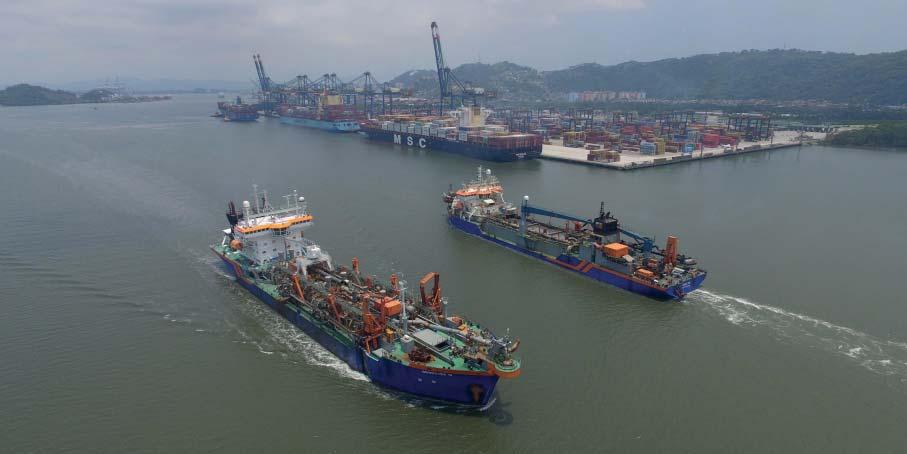
Port managers should not be appointed by politicians, but rather be competent professionals
‘‘
Hosted by:
• Freeports: Driving change for coastal





Delegate place includes:

•Conference attendance including lunch & refreshments
•Technical Visit
•Electronic documentation


• •
attendees representing shipping lines, ports, logistics companies, terminal operators and freight organisations.
For more information on attending, events team: visit: coastlink.co.uk contact: +44 1329 825335 or email: info@coastlink.co.uk

Media partners:
Supporters:
The outgoing Santos port administration has turned in record profits, but the new Ports Minister has signalled he does not see a future for the proposed whole port privatisation. Rob Ward explains
Santos Port Authority (SPA) has returned record profits over the past year as its management team strives to create a leaner, more efficient operation making it even more attractive to investors for a privatisation push… although that process will reportedly now be put on the back-burner with a new left-wing government in Brasilia.
Fernando Biral, the outgoing president who has headed up SPA since April 2020 and was Chief Finance Officer before that, told Port Strategy that the regular record profits in recent months were part of his team’s legacy to the port authority and he hoped that the soon-to-be appointed new president of SPA – yet to be named (at the time of writing) - will also instil a “professional ethos” to the management of the staterun entity and try and “keep politics out of the SPA”.
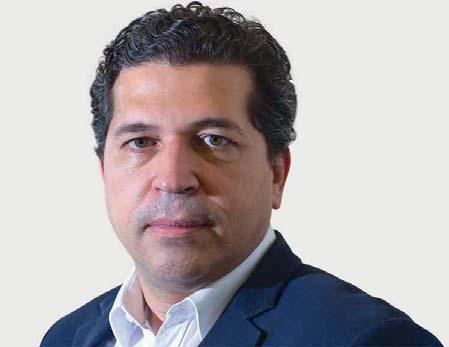
SPA recorded a net profit of Reais416 million (US$80m) for the first nine months of last year, which was 55.2 per cent higher than for the same period of 2021, and more than for the whole of 2021! (which registered Reais329M profit). Cargo handling for the third quarter hit 42.8m tonnes (up 17.2%), itself a quarterly record, and the forecast for full-year 2022 at the rapidly expanding Brazilian port is for 164 million tonnes (including 2.5m TEU).
“We are clearly delighted with these figures which are a result, mostly, of contractual readjustments and the optimised allocation of certain port areas for transition contracts and new leases,” Biral told Port Strategy in a rare interview.
“These changes have been vital and absolutely necessary to recover the inflationary losses that we had after many tariffs were frozen since 2018. Overall inflation during the period has been around 25 per cent so the tariff increases, of around 13 per cent, were justified. The increase in volumes and adjustments in tariffs plus the curtailment of our costs have all helped.
“We are generating as much cash as we can so we can invest in projects that are within our strategic planning [the PDZ], such as building a new road, the perimetral, improving rail networks, plus deepening the channel [see preceding article] and other vital spending.”
He added that the pool of money now piling up in SPA’s coffers – believed to be in the region of Reais1.7billion (US$325.3 million) would also be used for something Biral called “Equilibrium,” balancing out compensation possibly/ probably owed to terminals judged by Antaq (the Brazilian agency for ports and shipping) to have suffered contract anomalies at the hands of Companhias Docas, like SPA. Santos box and breakbulk terminal Ecoporto [see Port and Terminal news] and ADM (a grain facility) are in this category.
However, just as PS went to press the new president of Brazil Luis Inacio da Silva (Lula), appointed Marcio Franca, a former Sao Paulo State Governor, as Minister of Ports and Airports (a ministry which in turn has replaced the wide-ranging Infrastructure ministry), and he has said he is not in favour of privatised port authorities.
That means that a key part of Biral’s intended legacy looks set to fall into the dustbin of history – at least for now – but he hopes that the “leaner, meaner, more efficient” SPA, will help
generate funds to pay for “urgently needed capital [deepening] dredging” and to pay off debts owed to port operating companies. Strong and regular maintenance dredging during the third quarter of 2022 led to overall costs rising 76 per cent up to Reais147 million, but without that dredging the SPA costs would have fallen by nearly 6 per cent, “proving how effective our strict cost controls have been in recent times,” added Biral.
Before the arrival of Biral, and his predecessor Casemiro ”Tercio” Carvalho, SPA regularly recorded financial losses (such as Reais94.9M in 2015 and Reais22.5M in 2016) but since they took over, every year has “yielded record profits” – Table 1.
Another aspect of the outgoing executive’s legacy to Santos is a “New Deal” between SPA and the three railway companies that use South America’s biggest port
“We are about to sign ground-breaking contracts with the three main railways using Santos - Rumo, MRS Logistica and VLI – and my team here at SPA have been working incredibly hard on this,” explained Biral. He added that the contracts, called “estatutoes”, were like concessions with terminals but with “some differences” and the aim was to “double cargo moved in/out of Santos by rail from 50 million tonnes per annum to 100 million tonnes.” The extra cargoes would be mostly grains, but also containers.
“Biral and Tercio ruffled more than a few feathers during their time in charge,” said one former port terminal director, who had dealings with them. “But overall, turning in a decent profit can be good for the port if the money is used for improvements, such as much more dredging.”
8 Table 1: Santos Port Authority – Net Profits, showing a distinct uplift in 2020 and 2021The focal point of southern African port operations has always been South Africa but stagnant development and uncertainties with regard to management and – especially – the tortuous privatisation saga suggests opportunities for other regional players. AJ Keyes takes a look
South Africa’s ports appear to have many of the necessary reasons needed for success – established infrastructure, large population to serve, landlocked countries within reach and limited maritime competition. Yet the truth is vastly different, with the port and shipping industry in South Africa continuing to face many problems, including:
4 The failed rail privatisation and whether the Durban process will happen, with vested interests seemingly against it.
4 The focus of demand remaining Gauteng and threat posed by Maputo, even with border issues.
4 Long history of effort at Ngqura but little progress.
4 Rationale of developing a new port when the focus will remain on Durban, balancing theory and reality.
The other southern African countries of Namibia and Mozambique are much smaller, but are their ports able to take advantage of South Africa’s years of inefficiencies or does that represent a step too far?
As Figure 1 shows, there are a number of ports in all three countries handling containers, with these three countries having a combined 2020 population of 93.2 million people. Add further inland markets of Botswana (2.5 million) and Zimbabwe (14.9 million) and this gives a southern Africa total of more than 110.5 million people. Ports and inland transport infrastructure need to be up to the task.
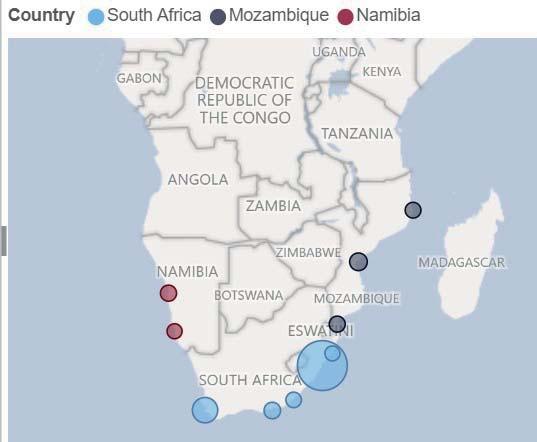
Privatisation has long been a theme in South Africa, albeit with little traction gained in the ports and rail industry in the past 20 years, despite numerous instances of promised action. In June 2021, Cyril Ramaphosa, State President, announced structural reforms to smooth the process with Transnet National Ports Authority (Transnet), which manages all eight commercial ports in the country, to be converted into an independent commercial company and revenues from port activities invested back into infrastructure. He said Transnet would seek proposals from the private sector for the ports of Durban, which handles 65 per cent of total South African port volumes of over four million TEU, and Ngqura. However, at the start of 2023, little tangible traction has occurred.
David Maynier, Finance and Economic Opportunities MEC has since called for Cape Town to be privatised because the port is a “disaster zone.”
Despite many obvious challenges, there continues to be no shortage of interest in South African ports from the private sector. Transnet confirmed that 10 companies made the shortlist for Durban Pier 2, which includes the likes of APM Terminals, Cosco Shipping Ports, DP World, HHLA, ICTSI, Red Sea Gateway/MMC Port Holdings and Abu Dhabi Ports.
Similarly, for Ngqura Container Terminals respondents invited to proceed were APM Terminals, Red Sea Gateway Terminals/MMC Port Holdings, Abu Dhabi Ports and TiL –again, all heavy hitters in the terminal operating industry.
Transnet announced in mid-2022 that 25-year special purpose vehicles would be created, yet unsurprisingly the preferred bidder deadline appointments slated for February 2023 looks certain to be missed, albeit that Transnet is maintaining a positive spin: “The improvement in port
efficiencies will support South Africa’s competitiveness and our ability to grow jobs in the manufacturing and export economy. Partnering with global port terminal operators and shipping lines offers the opportunity to attract much-needed investment, instil best-practice management and enhanced technological capability to rapidly improve the performance and volume throughput at the Ports of Durban and Ngqura,” it states.
It is no surprise that the pro-private lobby regard privatisation as the panacea to problems of inefficiencies at major ports like Durban, especially when strike action causes havoc across the industry, as it did in the latter part of 2022. Strikes by members of the South African Transport and Allied Workers Union and the United National Transport Union in October 2022 caused significant supply-chain disruption and wider economic chaos.
South African exporters pointed out the damage caused by the strikes. The Minerals Council of South Africa reported that the ports for mineral exports were operating at under 30 percent of their daily averages and in some cases as low as 12 per cent of normal volumes. As a result, estimates were put forward suggesting the strike cost South African miners US$44 million a day.
This privatisation of the port industry is following on the heels of a very uninspired process involving rail in South Africa and that does not bode well, especially with an overall sense that Transnet’s process was set up for failure. The government auctioned slots on its rail network, albeit only short-term contracts for two years, and thereby making it highly unlikely that any concessionaires would invest sufficient sums due to an inability to achieve financial payback.
Yet despite the ailing rail infrastructure there were still 19 interested parties chasing 16 slots. However, only one bidder ultimately proved successful and while the Kroonstad to East London line was made available to private freight operator, Traxtion, it does not qualify as a premier link in the national freight system.
The need for private investment clearly remains. The African Rail Industry Association (ARIA) states that at least R27bn (US$1.6bn) of underspending on maintenance by Transnet over the past decade occurred, evidenced by general freight line efficiency falling by 38 per cent during the past five years because of faulty infrastructure. ARIA currently estimates that the rail share of cargo could fall as low as 10 per cent.
One shipper who wished to remain nameless summed up the problem: “Absolutely what the government always does, exhibit willingness to let the private sector in, and then either put so many stumbling blocks in the way that little comes of the initiative except frustration, or not keep its part of the bargain by providing decent infrastructure.”
Given its performance, it is hard to imagine that the desire of Transnet to increase its tariffs by up to 24 per cent in the 2022/2023 fiscal year simply would be possible in a privatised environment.
Yet despite the issues over privatisation and operating challenges, Transnet continues to stress its largescale expansion plans, most notably in Durban, which will see 11.3 million TEU of capacity available, plus an entire range of investment in the East Cape area. It is difficult to see traction being gained without private sector involvement, at least to the scale desired by Transnet, with the 10-year build out cost for Durban alone put at R100 bn (US$5.8bn), which compares to Transnet’s 2022 fiscal year revenues of R68.5 billion (US$4.1bn).
So, with the year-on-year malaise continuing to manifest itself in South African ports, the obvious question is whether ports can take advantage in either Mozambique or Namibia?
In Mozambique, the principal port is Maputo, which is operated by Maputo Port Development Company (MPDC), owned by Dubai Port World. The port is well-positioned to serve the province of Gaza, Swaziland, Zimbabwe, Botswana and the Transvaal region of South Africa, although unlocking the landlocked regions of the Mpumalanga, Gauteng, and Limpopo Provinces is crucial and the Maputo Development Corridor has been established to complete the task. The key area here is Gauteng, the “Place of Gold” which generates 40 per cent of South Africa’s GDP offering the highest concentration of manufacturing and industrial production in the country.
MPDC has confirmed that the Corridor has the support of both the governments of Mozambique and South Africa, but still needs further private sector help, plus improvements to border procedures and operating hours and more capacity, competitive transport rates and greater service efficiencies in the inland supply chain. Without this support, the corridor will not gain “full optimisation” the organisation states.
DP World stepped up its support with a dedicated container train service connecting Maputo (Mozambique) and Harare (Zimbabwe), but it is the ability to serve the greater Johannesburg area that must be targeted. DP World is landing container imports in Maputo destined for South Africa and moving them under bond to Komatipoort for full customs clearance and onward delivery, but this is still over 450km from Johannesburg.
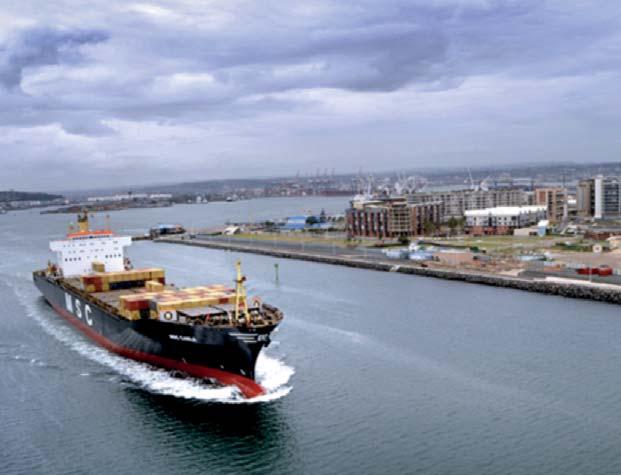
CMA CGM has followed DP World’s lead by starting an intermodal weekly service of 108TEU to serve Harare province in Zimbabwe, while complementing existing links via the Port of Beira in Mozambique (and connections via Durban). While, however, both services represent good examples of better logistics services, they are clearly insufficient to see cargo transfer away from South African ports. The pressure here will remain because shipping lines are building capacity, for example, Ocean Network Express (ONE) upgraded its Maputo/Mombasa India Middle East service (MIM) from fortnightly to weekly from January 2023.
The position is similar in Namibia. The government has known plans to scale-up transport infrastructure to meet its Fourth National Development Plan (NDP4) and Vision 2030 aims.
New berthing and cranes have recently been added at the Port of Walvis Bay to raise annual capacity from 350,000 to 750,000TEU, to serve ships up to 8500TEU, but its last fiscal year results confirmed volumes of just 168,278TEU, representing a low utilisation level. This could change, however, with MSC’s terminal investment arm, TiL, being named as operator of the port’s container terminal. Andrew Kanime, CEO, Namibia Port Authority (Namport), expects a deal to be done soon: “We envisage to finalise the negotiation and handover process by the first quarter of 2023.” It is a decision that could help boost container port volumes handled.
Namibia has favourable geographic positioning, bordering Angola, Botswana, South Africa, Zambia and Zimbabwe and there is spare port capacity with modern infrastructure, so pressure remains on the efficiency and quality of inland connectivity. The NDP4 plan targets upgrading 1480km of roads, but the border to South Africa, at Keepmanstoop, is 545km from the port, the distances, time and costs can be substantial, especially for rail and when compared to the closer Maputo option.
Ports in South Africa remain the logical focus for local, regional and transit demand, but the continuous issues effecting ports represent a handbrake on achieving progress. Decisions taken in South Africa and bordering countries in the next five years will determine the outcome, but experience shows it may not be wise to anticipate rapid development in South Africa.
8 Will port privatisation make real progress in South Africa? The jury is out…Gavrylyuk details Russia’s reaction to economic sanctions – the changes of direction in trade volume and value terms, and the opportunistic role Turkey is playing
Despite international economic sanctions being in place against it, in 2022 Russia, managed to increase the volumes of its trade with a range of foreign countries Surprisingly these included the European Union (EU) member-states of The Netherlands, Spain and Belgium which registered growth of 32, 57 and 81 per cent respectively over 2021 performance.
However, it was the Kremlin’s economic ties with Middle Eastern and Asian nations that generated the most impressive figures, as recently confirmed by a report from Moscowbased Associated Cargo Experts (ACEX). The report identifies Russia as positioning itself as a key player in a ‘Eurasian International Logistics Alliance’.
The 64 per cent annual growth achieved in Russo-Chinese trade is not a big surprise, given the two countries longstanding ‘special relations.’ What is particularly notable, however, is the rocketing trade growth achieved with Turkey and India, comprising increases of 198 per cent and 310 per cent respectively over 2021 trade volumes.
The underlying financial realties of such increases do not always, however, tell such a positive story – in the case of India, for instance, the value of trade rose from US$13.5 billion in 2021 to slightly more than US$30 billion in 2022, just over double whereas the actual trade volume registered a much larger increase. To a large extent, this reflects New Dehli’s opportunistic buying of Russian energy resources at a steep discount, within a short period, facilitated by restrictions in traditional western markets.
Turkey, on the other hand, has fared much better. According to Russian market experts, the overall turnover between Moscow and Ankara leapt to US$30 billion at the half year point in 2022, compared with the US$33.5 billion achieved for the whole of 2021. Furthermore, data provided by the staterun Turkish Statistical Institute (TurkStat), shows Russian imports (chiefly commodities) totalling US$54.3 billion during the first 11 months of 2022. Practically speaking, this identifies Russia as the leading exporter to Turkey followed by China with a value figure of US$37.7 billion, Germany with US$21.5 billion, the USA with US$14.4 billion and Switzerland with US$12.8 billion and so on.
In the January-November 2022 period, Germany with US$19.3 billion, USA with US$15.5 billion, Iraq with US$12.6 billion, UK with US$11.9 billion and Italy with US$11.3 billion were the leading importers from Turkey.
As the Kremlin did not “qualify” for a top five position, TurkStat does not elaborate on its share.
While the West has in general scaled down trade with Moscow, Turkey seems to be determined to get the most out of the current political situation and its geographical location.
With Russia having virtually lost its direct maritime links with the EU, Turkey now fulfils the role of Moscow’s only trade partner in the Black Sea basin and, even more important, its transit bridge to the entire Mediterranean region and the rest of the world.
Under the circumstances, Turkey’s mega-port of Istanbul with its well-developed infrastructure, has been evolving into the key hub for transhipping containerised cargoes moving to and from Russia through the Turkish Straits.
For example, in late October-early November 2022, FESCO, the Russian transport and logistics group, launched FESCO Black Sea Service (FBSS), its first regular (fortnightly) deepsea line connecting Russia’s Black Sea harbour of Novorossiysk with China’s Pacific ports of Shekou, Ningbo, Shanghai and Qingdao via the Suez Canal.
According to FESCO, it takes FBSS 40-45 days to deliver China’s consumer goods to Novorossiysk, including 30-35 days for reaching Istanbul, where containers are transhipped from an ocean carrier onto feeder ships.
Earlier in 2022, Ruscon, a Novorossiysk-based Third Party Logistics (3PL) operator, started consolidated shipments from Turkey to Russia. Under the project, goods from all over the country are brought to Istanbul, then shipped in containers to Novorossiysk and finally railed or trucked throughout Russia.

In addition, ship operators launched, last year, several ro-ro/ferry services linking Istanbul, as well as Turkey’s Black Sea ports of Karasu and Samsun, with those of Novorossiysk, Kavkaz and Temryuk on the Russian littoral. The services are maritime legs of the intermodal routes between the two nations’ various hinterland destinations.
With Moscow’s growing international isolation, Turkey’s ports have been playing an increasingly significant role in supplying Russia’s manufacturers and consumers with numerous sanctions-hit raw materials and industrial products (such as automotive parts and components, other machinery and equipment).
Furthermore, the Kremlin has been inventing increasingly crafty transit channels and schemes for delivering so-called parallel imports (violating intellectual property rights, but being of vital importance for the country) to Russia via the Turkish ports.
At the same time, recognising that Turkey’s terminals have their limits, Moscow has begun eyeing Egypt’s , Mediterranean harbour of Alexandria which could also fulfil the role of a relay point for Russian cargo.
8 FESCO has expanded its hub operations based on Istanbul, Turkey and is reportedly now looking at the port of Alexandria, Egypt as another potential hub
8 Optimising equipment solutions for the new MPT now under development in East Port Said was an important aspect that flowed out of the MTBS studies
SCZone for a new Multi-Purpose Terminal in East Port Said, Egypt, heralds the introduction of the first terminal of this kind to be awarded on a whole terminal basis.
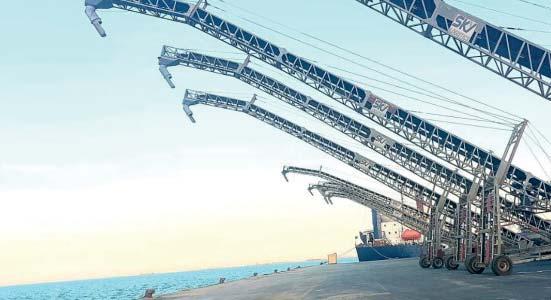
Sky Investments, in cooperation with Reliance, has signed a Concession Agreement with SCZone for the new MultiPurpose Terminal (MPT) in East Port Said. This strategic deal aims to expand the port’s cargo services and increase the competitiveness of the service levels offered in East Port Said. For the development of this new terminal, featuring a 900m quay and landside area of 38 hectares, a total investment of USD65 million is to be implemented by the consortium.
Sky Investments is a private investment group, consisting of 12 subsidiaries and 7000 employees across four diversified industries, and has its core focus on the Egyptian market. Among its main subsidiaries is Sky Logistics which is specialised in providing integrated and customised logistics solutions including customs clearance, road transport and stevedoring activities.
Reliance is a group specialised in bulk commodity trading, logistics, mining & mineral supply, concrete ready mix production and shipping & waste management. As such, Reliance is well positioned in, among others, the Egyptian clinker and cement industries and thereby complements the strategic fit for the MPT.
The Egyptian Suez Canal Economic Zone Development Authority (SCZone) is the port authority of East Port Said (EPS). SCZone announced at COP27 multiple developments to expand the port’s cargo activities, including the new MPT. With the concession in place, the Consortium becomes the first private organisation in Egypt to operate their own entire MPT. This creates a paradigm shift in Egypt which has
(1)MTBS is an international finance and strategy advisory firm, offering entrepreneurial business solutions to clients in the maritime and transport sector. Since the company was founded in 2005, MTBS has specialised in ports and terminals, and provides expertise in PPP transactions, strategy, valuation, institutional analysis, financing and economic analyses. The firm combines its market sector knowledge and state-of-the-art financial competences into one value proposition: “4P: innovative solutions for Port Public Private Partnerships”
operated by public organisations and only the stevedoring is performed by private companies.
It is Sky Logistics’ ambition to handle over five million tons of cargo in the near term, including, among others, coal, clinker, cement and scrap metals.
To align with SCZone’s green port ambitions, a package of measures have been adopted by the Consortium ranging from investing in electrical equipment and energy efficient LED lighting on the terminal to installing rooftop solar panels, performing waste separation and so forth.
During their study phase, the consortium was supported by Maritime & Transport Business Solutions (MTBS)(1) to conduct a fully-fledged feasibility study. The entire project took more than a year to complete, explains Dirk van Niekerk, manager at MTBS. The first part of the project focused on the market analysis in which the potential of the terminal was verified by determining the commodities with the most potential and originating a detailed forecast for each. This formed the foundation on which the financial feasibility and bankability of the terminal development was tested. A key area of analysis was identifying the competitive advantages the EPS MPT could offer to its clients for various cargo segments with this focus including:
5 The ability to handle larger vessels due to the CD -18 metre depth alongside the quay.
5 The superior vessel productivity, which is enabled thanks to investments in state-of-the-art vessel handling equipment and the benefits flowing from Sky Logistics operating its own terminal, and
5 A location in the proximity of Egypt’s main production and consumption centres including Cairo, the 10th of Ramadan, the Sinai region and Sokhna.
Omar El-Badry, CEO, Sky Logistics, underlines his satisfaction with the concluded results: “Thanks to MTBS we were able to fine tune our investment planning with the aim of achieving our intended operational excellence as well as optimising the provisioned financials of the project.”
With guidance provided by MTBS(1), a new multi-purpose terminal concession under development in East Port Said, Egypt will see the country adopt a first of its kind operating model
Changes are underway in the international dredging market – there is a growing emphasis on new generation project funding arrangements and exploiting new areas of business opportunity. AJ Keyes investigates
8 The Paraná–Paraguay waterway is crucial in supporting the largest agri-food production area in the Mercosur trading bloc of countries – a long term concession opportunity is in the pipeline

Today’s front rank international dredging contractors have a lot more tools in their armouries when it comes to securing projects and in key markets are seeing the opening up of new areas of business opportunity.
Step by step, there is growing interest in deploying equity investment, use of tolls and other innovative approaches as a path to securing projects, sometimes supplemented in part by the conventional contract-payment relationship. There is more flexibility when it comes to agreeing payment arrangements – the equity option, potentially at least, also offers the prospect of what can loosely be termed a project bonus via the process of adding value and then at the appropriate moment exiting the project. The toll system of payment – based on fees collected from vessel operators –has also matured progressively since its introduction in the early 1990s, in conjunction with a concession for the dredging and development of the waterway between Punta Indio on the River Plate and Santa Fe on the Parana River. Elements in such concession agreements like a greater focus on dredging performance and the resulting accountability of the contractor have been introduced and refined with significant benefits to waterway users.
The volume of dredging work continues to flow from traditional sources with a catalyst, where major projects are concerned, provided by the new model funding arrangements. It is true to say that they make some projects viable which were not previously regarded as being ‘doable.’
There are also positives in sight from a diversification of activity, notably with a number of dredging contractors gearing up to undertake specialist work in the offshore wind sector. The war in Ukraine has accelerated the need for energy diversification, especially when combined with a drive for clean fuels. It all adds up to growing opportunities for dredging contractors.
Now in the pipeline are new dredging opportunities which embody non-conventional funding arrangements – the concession agreement is one flagship vehicle in this respect. A good example of this is the 3400km-long Paraná–Paraguay waterway that links the Paraguay, Paraná and La Plata rivers, across Paraguay and northern Argentina to the Atlantic Ocean.
The importance of this waterway to Argentina, in supporting the largest agri-food production area in the Mercosur trading bloc, can be traced back to 1995 when permission for dredging was given to deepen the water depth for larger vessels as part of a concession secured by Belgium’s Jan de Nul and Argentine partner, Emepe. As a result, exports of grains, oils and related products increased from 29 million tonnes to 100 million tonnes annually on the basis of ships carrying around 47,000 tonnes per sailing, but larger ships could carry between 65,000 and 70,000 tonnes per vessel.
However, for greater economies of scale in export shipments to be achieved a new concession needs to be arranged because the existing one expired in 2021, resulting in the government placing the matter into the hands of its own General Administration of Ports (AGP) until a new bidding process is completed.
The need for the investment to deepen this waterway is confirmed by Gustavo Idigoras, President, Chamber of the Oil Industry of the Argentine Republic and Cereal Export Centre (CIARA-CEC): “Deepening of the waterway through dredging will allow ships of greater draught to enter, which would reduce costs and will imply giving access to the sea to producers from Argentine regions that today do not have access to it due to economic reasons.”
Additionally, Alexis Guerrera, Transport Minister, Argentina, recently noted that the state is: “obliged to update the
waterway” directly.” As a result, the management of the waterway, and the responsibility to meet the necessary dredging costs, remains with the General Administration of Ports (AGP), but as the organisation does not have the capacity to undertake the service, it must continue to subcontract it out to specialist companies.
In the short term, the solution is to maintain the status quo, with AGP extending the current arrangement with Jan de Nul until the bidding process is completed. In Q4 2022, the government confirmed the following: “Regarding the dredging, a short-term contract will be made for Jan de Nul to continue for a while, as the tender will be launched at the same time. It is already agreed that it will continue with Jan de Nul.”
The value of the next concession contract is put at in excess of US$3.7 billion. It is expected to be hotly contested with bidders in consortia, operating with local partners and possibly solo originating from Europe, Asia, Latin America etc.
There are issues surrounding the collection of tolls. One is will this function be retained by AGP, who took it over at the end of the last concession or will it be passed to the successful bidder? Equally, there are now diplomatic issues to resolve concerning toll collection with at the beginning of January Paraguay calling for Argentina to cease collecting a new toll that had been applied to the Parana-Paraguay Waterway. It remains to be seen how Paraguay’s call for free navigability will be resolved.
The outsourcing of dredging works is also an aspect that raises issues. Idigoras states concerns about what the future holds: “It is imperative that the State offer guarantees to maintain the dredging.” It is a valid point, of course, - previous arrangements on these waterways have seen contributions from government alongside toll fees and this option may well also come under consideration.
Concerns are also expressed by exporters about the potential uplift per ton-based toll fees. In short, there are lot of issues circulating around the proposition of a new concession.
There is a similar choice to be made in Colombia, with the government assessing its options regarding the US$480 million project to improve navigability on the Magdalena River which runs over 1500km from the Andes to the Cartagena area and thus the Caribbean Sea. Cartagena is, of course, a major containerport location and as such there is an inevitable logic to using the river for container transport as well as for other commodities. The river offers the potential to establish key inland hubs serving as major regional distribution points.
Constantza García, Deputy Infrastructure Minister, confirms that the government will continue to invest in keeping the river navigable and elaborates on the government’s stance: “We are evaluating whether it is a public work or if we return to a public-private partnership. Today we’re leaning more towards a public work to carry out the civil works that are required, to dredge the river and the channel.”
The 2023 governmental budget offers some support, with 183 billion pesos (US$37 million) allocated towards dredging in the country, of which almost 90 per cent will go towards the Mompós area, some 120km upriver from open water. This is despite the waterway itself totalling 1500km in length.
This is a small figure, especially when the majority of the funding is expected to be spent in one specific area. With the pre-bidding documents to support the contracting process for the Magdalena River navigability including ‘revenues from the collection of fees for the use of the canal,’ there is an appealing mechanism open to candidate contractors.
There is also a bigger pool of experience to draw on
nowadays including in Ecuador. Jan De Nul Group has the concession contract for the deepening and maintenance dredging of the 95km access channel to the port of Guayaquil in Ecuador. The company operates and maintains the channel under a 25-year performance-based concession contract. The deepening and maintenance of the channel system is financed by Jan De Nul Group and recuperated by tolls.
The concept of taking an equity stake or making financing available is an established one for China Harbour Engineering Company (CHEC), with this company already investing in Laem Chabang Port Phase 3, terminal F with a 30 per cent equity stake in the new US$1 billion project and a US$221 million contribution as majority shareholder involving Lekki Port in Nigeria. That said, the company has not been without its controversies, with its involvement in the Port of Hambantota in Sri Lanka, resulting in it being debarred by the Word Bank for bribery, according to several reports in the international press.
There may also be new additions to the global dredging business. State-owned Dredging Corporation of India (DCI) has announced a move into global activities, following a dredging contract in Mongla Port in Bangladesh, a port accessed via a long river system which will require ongoing dredging maintenance. The port is situated at the confluence of the Pashur River and the Mongla River and lies about 100km north of the Bay of Bengal
WIND OF CHANGE
Evolving strategies relating to accessing dredging projects is not the only area where dredging contractors are seeing interesting developments. More opportunities are now coming to the fore in the offshore wind industry representing a healthy area of business diversification. Indeed, during 2022 a number of projects in this sector have been confirmed or seen considerable progress made.
In November 2022, Van Oord confirmed it had been selected as preferred contractor to construct the Baltic Power offshore wind farm, located 23km off the coast of Poland. Here Van Oord will transport and install more than 70 foundations, consisting of a monopile fitted with a transition piece. Construction of the farm is planned to start in 2024, with commissioning from 2026, whereupon renewable energy will be supplied to 1.5 million homes in Poland.
Additionally, during Q3 2022, Van Oord and Subsea 7 secured a contract from ExxonMobil affiliate Esso Exploration and Production Guyana Limited (EEPGL) for the Gas to Energy project, offshore Guyana. The consortium’s scope includes project management, engineering, and installation of approximately 190 km of natural gas pipeline in water depths up to 1400m, running from the Liza field in Guyana’s offshore Stabroek Oil and Gas Block to an onshore natural gas fired powerplant west of the Demerara River, along the coast of Guyana. Operations are scheduled to commence in mid-2023.
DEME and Jan de Nul also report significant offshore wind projects and with diverse catalysts now encouraging further similar projects. The prospects overall look good.
….emerging opportunities in the offshore wind industry promise to progressively benefit leading dredging companies
‘‘
Technical innovation is playing an increasingly influential role in optimising the berthing process. New thinking and recent systems innovations are to the fore
8 Port and vessel operators are promptly notified via PortXchange if there are any changes in scheduling – real time connectivity is key
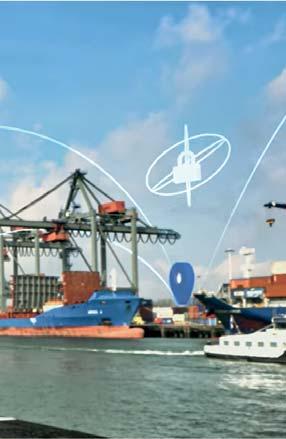

Efficient vessel berthing can be influenced by a multitude of factors - sudden changes in weather, changes in ocean conditions, berth availability, congestion and the inability of vessel crew to respond quickly to any last-minute changes of plan etc. can all have an impact.
Overcoming such challenges, in a logical and safe manner, has in recent times become the focus of significant technical innovation assisted by the advent of the digital era. Notably, there is an emphasis on simple, accessible systems that store all the required information for fast decision making – a step on from what can be termed a more manual approach to vessel berthing.
Key drivers behind the emphasis on technical innovation to deliver safe and efficient vessel berthing include:
4 A regulatory framework, focused on driving decarbonisation within the maritime sector that has evolved over the last few years – typically IMO’s targets to cut the sector’s emissions in half by 2050.
4 The Just in Time (JIT) Arrival Guide developed by the Global Industry Alliance to provide the port and shipping sectors with practical guidance on how to facilitate JIT arrivals and achieve the inherent efficiencies that go with this.
4 The Baltic and International Maritime Council (BIMCO) Just in Time Arrival Clause was also introduced in 2021 to encourage the greater adoption of this concept as a means of increasing shipping procedure efficiency and reducing CO2 emissions.
“The industry’s focus on decarbonisation is especially important within the context of ports,” says Bruce Mills, Business Development Lead, Ports, Wärtsilä. “As the connection between supply chain infrastructure on land and at sea strengthens, ports will have a pivotal role to play in enabling resilience and emissions reduction across the endto-end supply chain.”
Systems supplier OneOcean cites the figure of six per cent as the average time that working containerships spend at
anchor – which means of course they are racking up costs as opposed to earning revenue. There is, therefore, alongside objectives such as decarbonisation and optimising supply chain operations overall, a strong commercial incentive to achieving timely and efficient vessel berthing.
So where does the process start to achieve JIT berthing?
The consensus on this is the real-time connection of all stakeholders: vessel operators, port authorities, terminal operators and other parties has to be achieved. This is an issue highlighted by Mills in the accompanying article in this issue, Overcoming Digital Fragmentation, where he emphasises the need to get away from what can be called data silos, unable to inter-connect with each other, and thus reap the benefits that standardisation offers. He says: “Taking a holistic approach can be transformational from a supply chain perspective. With greater supply chain connectivity and data-sharing comes the potential for JIT operations and the associated benefits. Not only can JIT arrivals reduce fuel use for ship operators, they can reduce congestion and delays in ports, thus improving safety, competitiveness and resilience of maritime operations.”
There are a good number of digital packages that can contribute to efficient berthing, the big question is connectivity. Where in the transport chain do they start? Voyage planning for vessels is identified as making a useful contribution to the process. OneOcean’s Passage Manager, system, for example, offers all data required on the viability of sea routes including routing parameters, vessel equipment and weather conditions. With all the necessary information housed in one place, this is said to make berth-to-berth voyage planning much easier.
OneOcean also offers other packages to the vessel operator that it says can facilitate JIT arrivals – there is FleetManager which aims to provide full situational awareness to shoreside stakeholders on the whereabouts and status of their entire fleet. This data, OneOcean contends, can prove to be an important link in the JIT value chain. There is also its Guide to Port Entry publication, and its digital
equivalent, findaport.com. The company notes: “Being notified that a berth is available and that the ship can enter port is one thing, but knowing the port’s exact layout, its applicable rules and regulations, procedures, and requirements are things altogether different. All the benefits of arriving just-in-time can be wasted if the port entry itself becomes strewn with challenges. Comprehensive port data can play a powerful role in providing a planned approach that is efficient and minimises unnecessary manoeuvring.”
There are also structural changes required to facilitate efficient vessel berthing: OneOcean and Mills both cite the necessity of overcoming possible conflicts of interest in voyage charter contracts between the ship owner and the charterer. “As things stand,” OneOcean points out, “extended laytime with the vessel at anchor awaiting a berth can deliver demurrage benefits to the owner, while a JIT arrival would minimise the laytime and thus benefit the charterer.”
Equally, there is the issue of cargo being ready for loading at the terminal and the terminal properly set up to handle discharge operations which, in turn, can impact the interfacing of land-side transport systems. Real data connectivity is again key.
STEADY TAKE-UP
There is steadily growing activity regarding the adoption of digital solutions for efficient vessel berthing and cargo discharge/loading.
A five-year partnership was recently confirmed between liner shipping company, Hapag Lloyd and Portchain to deploy Portchain Connect across its global operations. Portchain Connect digitises the process of aligning berths between carriers and terminals, enabling them to make timely and more frequent scheduling decisions.
Using Portchain Connect, Hapag-Lloyd will transform traditional email and phone communication into a digital information flow for aligning berth arrival information with terminals, giving its terminal network immediate access to schedule updates and key vessel call information on the platform.
The alignment process provides the opportunity to capitalise on the benefits of JIT arrivals – a process which the IMO estimates can reduce CO2 emissions and bunker consumption by 5.9 per cent in the 24 hours leading up to arrival.
Shekou Container Terminals is another company to recently implement Portchain Connect and similarly Antwerp Gateway, where DP World is the operator.
Also of note, the Port of Algeciras has worked on a pilot project in conjunction with Maersk Line, APMT Marmedsa and PortXchange. As well as helping to lower emissions, the PortXchange platform provides one central focal point for all parties involved to be up to speed with unfolding real-time data. Port and vessel operators are instantly notified via PortXchange if there are any changes in scheduling. If a berth has to be rescheduled, this means that the vessel can
optimise its speed accordingly and lower the level of unnecessary emissions.
Looking ahead, Mills says the future of systems will be more integrated, whereby industry players will be looking at the entire vessel schedule. “This is where the JIT concept will play a critical role. Moving forward will be reliant on extending these capabilities and ensuring that they’re embedded in the whole operation.”
Elaborating, Mills says that the industry needs to explore how to extend the latest developments. “We need to look at a vessel’s schedule much further, beyond the next port of call. Instead, looking at the entire journey: so, not just vessel to port, but port to vessel to port. To do this, we need to better understand, not just the estimated time of arrival at the next port, but the estimated time of departure from the same port as that will be critical in determining what the estimated time of arrival at the port after that will be.”
However, this is where things start to get more complicated. He points out: “In order to be able to calculate the estimated time of departure from the next port we need to take into account many more variables. For example: are there any delays in cargo operations? Are there delays in employees coming onboard the vessel? Are there any delays in the availability of tugs to be able to depart the vessel?
“The good news,” he underlines, “is that advanced technologies, such as Machine Learning (ML) and Artificial Intelligence (AI), can support accommodating these variables. That’s because ML and AI technology can help us to make more informed decisions by, for example, helping to understand what’s happened in the past so that we can better predict what the likely estimated time of departure will be in the future.”
8 Portchain’s Portchain Connect, delivers digital information flow for aligning berth arrival information with terminals –the system is enjoying strong take-up including by Hapag Lloyd

Using Portchain Connect, Hapag-Lloyd will transform traditional email and phone communication into a digital information flow for aligning berth arrival information with terminals
ifm electronic gmbh ifm is one of the world’s leading sensor companies in the automation of measurement and control, optimizing technical processes in almost all industries.

+49 201 24 22 0 info@ifm.com www.ifm.com
Bedeschi S.p.A

For more than a century, Bedeschi is providing effective and reliable solutions in a wide variety of industries (bulk handling, marine logistics and mining), capitalizing on synergies and cross competences.
Via Praimbole 38, 35010 Limena (PD) – Italy
Tel: : +39 049 7663100
Fax: +39 049 8848006
Email: sales@bedeschi.com
Web: www.bedeschi.com
The BEUMER Group is an international leader in the manufacture of bulk material handling systems:
Overland Conveyor
Pipe Conveyor
Stacker & Reclaimer
Shiploader
Tel.: +49 2521 240
E-mail: info@beumer.com

Web: www.beumer.com
To advertise in the Port Strategy
NEUERO
Industrietechnik GmbH
Specialist for pneumatic ship unloaders and mechanical ship loader. NEUERO follows the MADE IN GERMANY quality tradition.
Now with more than100 years of tradition in the manufacture of reliable and high-quality conveyor systems worldwide.
Email: neuero@neuero.de
Tel: +49 5422 9 50 30 neuero.de/en/
Over 60 years supporting Container Terminals in port operations: we create strategic
STS Portainer® and RTG Transtainer® cranes, services & Advanced Port Technologies.

PACECO® CORP.
World Headquarters 25503 Whitesell Street Hayward, CA 94545
Tel (510) 264-9288
email@pacecocorp.com
www.pacecocorp.com
Tel: +33 4 50 65 61 97 connectors.sales@staubli.com www.staubli.com/en-de/ connectors/

11:29
Contact Arrate Landera +44 1329 825335 www.portstrategy.com
SAMSON Materials Handling Ltd specialises in the design and manufacture of mobile bulk materials handling equipment for surface installation across multiple industrial segments. Designed for rapid onsite set-up and continuous high performance SAMSON equipment provides an excellent return on investment.
SAMSON Materials Handling Ltd specialises in the design and manufacture of mobile bulk materials handling equipment for surface installation across multiple industrial segments. Designed for rapid onsite set-up and continuous high performance SAMSON equipment provides an excellent return on investment.
Gemini House Cambridgeshire Business Park, 1 Bartholomew’s Walk, Ely Cambridgeshire CB7 4EA England, United Kingdom (UK)
Taylor Machine Works, Inc.
Taylor Machine Works designs, engineers, and manufactures more than 100 models of industrial lift equipment with lift capacities from ,000-lbs. to 125,000-lbs.

13
15 TO JUNE 2023 Southampton United Kingdom
Gemini House Cambridgeshire Business Park, 1 Bartholomew’s Walk, Ely Cambridgeshire CB7 4EA England, United Kingdom (UK) Tel: +44 1353 665001 sales@samson-mh.com www.samson-mh.com
YOU CAN DEPEND ON BIG RED!
Tel: +44 1353 665001
Fax: +44 1353 666734 sales@samson-mh.com www.samson-mh.com C
Telestack are a leading global manufacturer of equipment for the bulk material handling industry including Ship Loaders/Unloaders, Hopper Feeders, Truck Unloaders, Bulk Reception Feeders, Stockpiling Conveyors, Link Conveyors and Telescopic Stackers.

Tel: +44 (0)2882 251100
Email: sales@telestack.com www.telestack.comw
#WeHaveTonnesToTellYouAbout
3690 N Church Avenue Louisville, MS 39339 USA +1 662 773 3421
www.taylorbigred.com
LASE Industrielle Lasertechnik GmbH

LASE offers innovative and productive solutions for ports by combining state-of-the-art laser scanner devices and sophisticated software applications. We are specialised in the fully automated handling of containers, cranes or trucks.
Rudolf-Diesel-Str 111
D-46485 Wesel, Germany
Tel: +49 (0) 281 - 9 59 90 - 0 info@lase.de www.lase.de
For more information visit: seawork.com contact: +44 1329 825335 or email: info@seawork.com
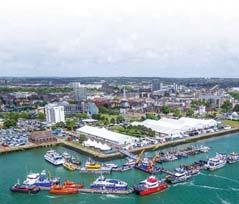
Rohde Nielsen A/S
Specialising in capital and maintenance dredging, land reclamation, coast protection, Port Development, Filling of Caissons, Sand and Gravel, Offshore trenching and backfilling
Nyhavn 20
Copenhagen K. DK-1051 Denmark +45 33 91 25 07 mail@rohde-nielsen.dk www.rohde-nielsen.dk
Telestack Directory June 2021 indd 1 26/05/2021 12:20
DRY AGRIBULK MATERIALS HANDLING SYSTEMS :
– Portable grains pumps
– Pneumatics continuous barge and ship unloaders 100-1200 tph
– Simporter twin-belt unloader up to 2500 tph
– Loaders up to 2500 tph
Complete turnkey projects
VIGAN Engineering S.A. Belgium
Tél.: +32 67 89 50 41
www.vigan.com/info@vigan.com
Heavy duty rol e-chain® P4HD.56R
P4.1 e-chain®
Energy chain with optional intelligent wear monitoring for double the service life, travels of up to 1.000 m, speeds of up to 10 m/s and fill weights of up to 50 kg/m.
The new heavy-duty rol e-chain meets all the relevant requirements for container cranes of the next and next-but-one generations. Longer and longer travels, greater dynamics, short stress cycles, zero failures.
VAHLE is the leading specialist for mobile power and data transmission

igus® GmbH
Spicher Str. 1a
D-51147 Köln, Germany
Tel. +49-2203-9649-0 info@igus.eu igus.eu/P4.1
igus® GmbH Spicher Str. 1a, 51147 Köln, Germany Tel. +49-2203-9649-0 info@igus.eu igus.eu/P4.1
VAHLE provides the solutions to reduce the carbon footprint while increasing the productivity. RTGC electrification including positioning and data transmission making RTGC ready for Automation.
Westicker Str. 52, 59174 Kamen, Germany
Email: port-technology@vahle.de Web: www.vahle.com
As one of the leading manufacturers of quick connector systems,Stäubli covers connection needs for all types of fluids, gases and electrical power.
ShibataFenderTeam Group
SFT is the leading fender manufacturer with +60 years of group experience in the design of safety critical fender system that protect vessels, port infrastructure and people.
We offer the full range of customized fender solutions and maintain production facilities for high-quality rubber products, steel panels and foam fenders. Join the safe side. contact@sft.group www.sft.group

CAMCO Technologies NV
Visual- and Micro Location- assisted process automation solutions for container, ro-ro and rail terminals worldwide Accurate crane, gate & rail OCR systems and Gate Operating System software helping terminals accelerate terminal and gate activity
Technologielaan 13 Leuven, Belgium
+32-16-38-9272
+32-16-38 9274
info@camco be www camco be
Conductix-Wampfler
The world specialist in Power and Data Transfer Systems, Mobile Electrification, and Crane Electrification Solutions. We Keep Your Vital Business Moving!
Rheinstrasse 27 + 33 Weil am Rhein 79576 Germany
Tel: +49 (0) 7621 662 0 Fax: +49 (0) 7621 662 144 info.de@conductix.com www.conductix.com
Fogmaker develops, manufactures, and markets fire suppression systems for engine compartments with high pressure water mist. Fogmaker is a market leader for automated fire suppression systems with 200,000 installations in more than 50 countries since 1995.

Tel: +46 470 77 22 00 info@fogmaker.com www.fogmaker.com
Künz GmbH
Founded in 1932, Künz is now the market leader in intermodal rail-mounted gantry cranes in Europe and North America, offering innovative and efficient solutions for container handling in intermodal operation and automated stacking cranes for port and railyard operations.

Gerbestr. 15, 6971 Hard, Austria
T: +43 5574 6883 0 sales@kuenz.com www.kuenz.com
Contact Arrate Landera +44 1329 825335 www.portstrategy.com

RTE CORPORATE HQ
We provide the most complete system of reliable data collection solutions for refrigerated transport terminals, vessels, and trucking operations through industry-leading innovations in remote reefer monitoring hardware and software products. Request a quote.
1 West Center Street McGraw, New York 13101 USA Within USA +1 877.538.7764 (Toll Free) International +1 607.836.8954
MRS Greifer GmbH


Grabs of MRS Greifer are in use all over the world. They are working reliably and extremely solid. All our grabs will be made customized. Besides the production of rope operated mechanical grabs, motor grabs and hydraulic grabs we supply an excellent after sales service.
Talweg 15-17, Helmstadt-Bargen 74921, Germany
Tel: +49 (0)7263 - 91 29 0
Fax: +49 (0)7263 - 91 29 12 info@mrs-greifer.de www.mrs-greifer.de
Orts GMBH Maschinenfabrik
Over 40 years experience constructing and manufacturing a wide range of grabs, including electro-hydraulic grabs (with the necessary crane equipment) radio controlled diesel hydraulic grabs, 4, 2 and single rope grabs all suitable for bulk cargo.
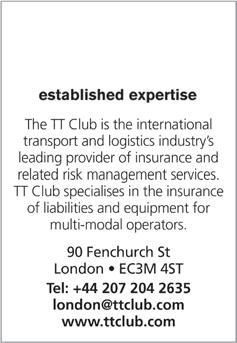
Schwartauer Str. 99
D-23611 Sereetz • Germany
Tel:+49 451 398 850
Fax: +49 451 392 374 soj@orts-gmbh.de www.orts-grabs.de

SANY Europe GmbH

offers a broad spectrum of high-performance mobile port machines such as Reach Stacker, Empty Container Handler, Heavy Duty Forklift Trucks and Material Handler
Sany Allee 1
Sany Allee 1
D-50181 Bedburg
50181 Bedburg, Germany
Tel: +49 2272 90531 100
Tel: +49 2272 90531 100
Email: info@sanyeurope.com
Email: info@sanyeurope.com
www.sanyeurope.com
www.sanyeurope.com
Sany ID indd 1 25/01/2022 11:42
VISYOy
VISY takes pride in solving operational problems, specialising in gate automation and access control solutions in ports and terminals. Their solutions streamline processes resulting in saving money and increasing productivity.
Visy systems reduce expenses, optimize safety & security, and increase throughput capacity via process automation. Our singleplatform gate operating system and OCR solutions manage all cargo, assets & personnel movements via quay, rail or road to keep operations moving.
Tel: +358 3 211 0403
Email: sales@visy.fi Web: www visy fi/
IDENTEC SOLUTIONS

is an industry-leading, trusted partner in managing and monitoring reefer containers and optimizing entire terminal operations through solutions like Reefer Runner and Terminal Tracker.
Contact: Stephan Piworus, Global VP Sales Marine & Ports, spiworus@identecsolutions.com; Mobile: +49 151 74122606 www.identecsolutions.com
The world leading manufacturer of Sideloaders, self-loading semi-trailers for versatile & efficient container handling. www.hammarlift.com info@hammarlift.com
TVH is a global player in the field of spare parts and accessories for heavy forklifts, reach stackers, container handlers, spreaders and terminal tractors. With over 96,000 references in stock and more than 644,000 known references, TVH offers quality replacement parts for many brands and makes, including the hard-to-find ones.
Tel: +44 2476 585 000 sales.team.uk@tvh.com www.tvh.com

ELME Spreader AB
ELME Spreader, world’s leading independent spreader manufacturer supports companies worldwide with container handling solutions that makes work easier and more profitable. Over 21,000 spreaders have been attached to lift trucks, reach stackers, straddle carriers and cranes.
Stalgatan 6 , PO Box 174
SE 343 22, Almhult, Sweden
Tel: +46 47655800
Fax: +46 476 55899
sales@elme.com
www.elme.com
With more than 30 years experience in IT Solutions and Business Operation Consultancy DSP offers a large portfolio of professional services and products to support terminal operations processes and system.
DSP Data and System Planning SA
Via Cantonale 38
6928 Manno, Switzerland
Tel: +41 91 230 27 20
Fax: +41 91 230 27 31 info@dspservices.ch www.dspservices.ch

Navis understands that as ships get larger and operational processes become more complex - efficiency, collaboration and productivity are essential. As a trusted technology partner, Navis offers the tools and personnel necessary to meet the requirements of a new, and ever-evolving, global supply chain.
World Headquarters
55 Harrison Street
Suite 600 Oakland
CA 94607 United States
Tel: +1 510 267 5000
Fax:+1 510 267 5100
Web: www.navis.com

Solvo Europe B.V.
Solvo’s software solutions such as TOS or WMS help container and general cargo terminals take full care of their cargo handling processes and make sure the clients expectations are exceeded.
Prinses Margrietplantsoen 33, 2595AM, The Hague, The Netherlands
Tel: +31 (0) 702-051-709
Email: sales@solvosys.com www.sovosys.com
Tideworks Technology provides comprehensive terminal operating system solutions for marine and intermodal terminal operations worldwide. Tideworks works at every step of terminal operations to maximize productivity and customer service.
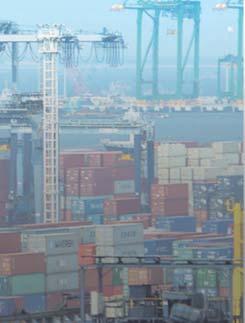
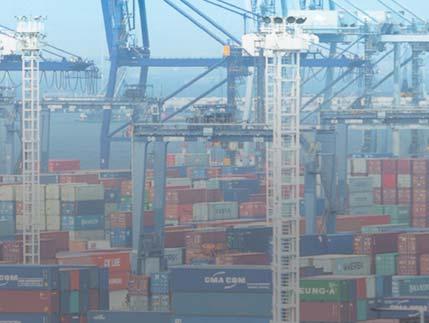
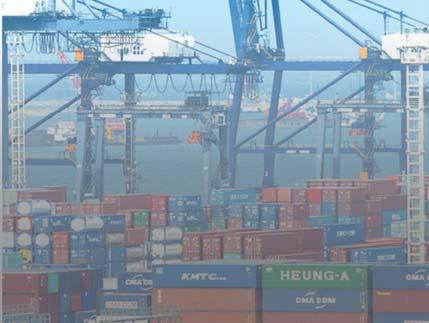
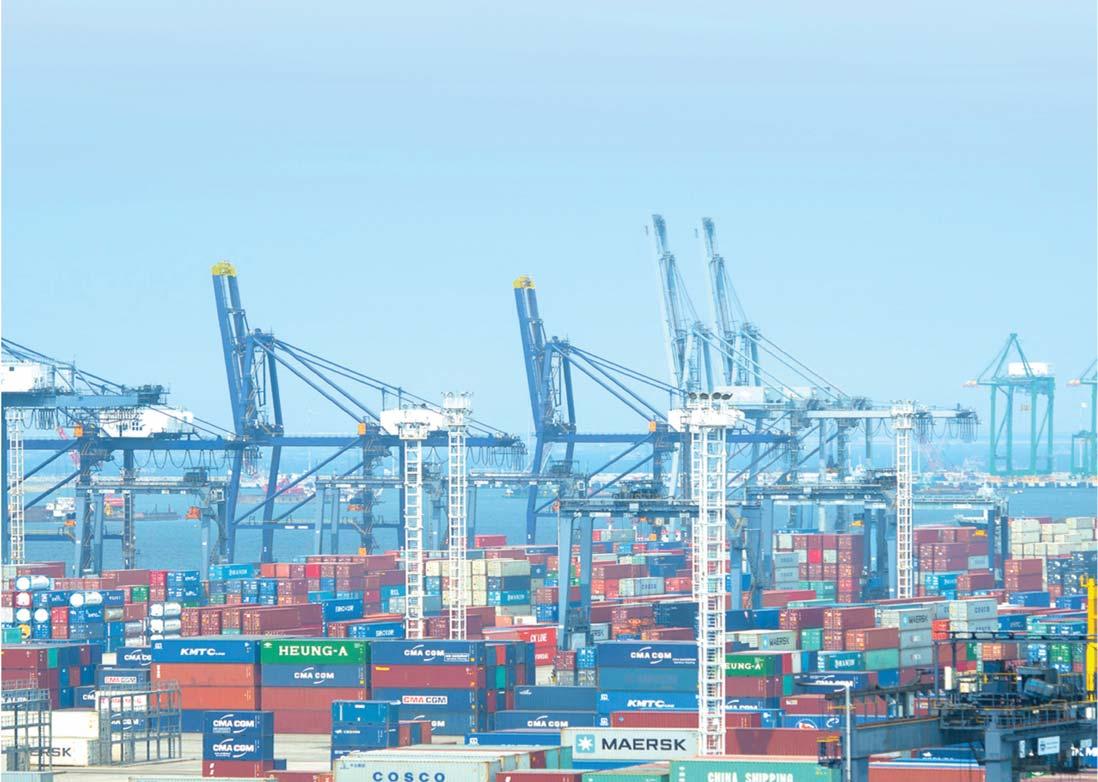

info@tideworks.com
+1 206 382 4470 www.tideworks.com
TGI Maritime Software is a Terminal Operating System editor and integrator specialized in the support of Small to Medium Terminals. Its expertise is built on 34 years of experience within the maritime sector. TGI provides comprehensive services to its customers all along their projects. OSCAR TOS and CARROL TOS have already been successfully handled by 40 container and RoRo terminals worldwide.
Tel : +33 (0)3 28 65 81 91 contact@tgims.com www.tgims.com
Specialised in the development and production of heavy-duty equipment for transporting containers, semi-trailers, cargo/roll trailers and special container chassis in ports and industry.
Hochhäuser Str 18 97941 Tauberbischofsheim, Germany
Tel: +49 9341 8990 sales@mafi.de www.mafi.de
Brunton Shaw UK is a successful manufacturer of high quality wire ropes for a wide range of applications. The company effectively combines more than 130 years of experience and tradition with an up to the minute range of products, and a customer service package ideal for the modern market place.
Tel: +44 1909 537626
Email: info@brunton-shaw.co.uk
www.brunton-shaw.com
Australia has traditionally had a strong interest in putting its waterfront industry under the microscope and considering how it can raise port performance. In the past much of the incentive to do this has flowed out of the troubled history of industrial relations on the waterfront and a recently released report, Lifting productivity at Australia’s container ports: between water, wharf and warehouse, issued by the Productivity Commission, does cite this as an area still worthy of attention but it also brings into focus a number of other key issues.
The general view is taken that higher productivity is achievable at Australia’s container ports and would deliver “significant benefits.” Variations in performance between the different container terminals is noted – a conclusion that is perhaps not that remarkable given that this is a common facet of container terminal operations and one that can stem from a myriad of local factors plus the reality that all facilities are not in the same age bracket.
In assessing container port performance, the report draws upon the World Bank’s Container Port Performance Index 2021 – it finds that compared with overseas ports, especially Asian ports, Australia’s major container ports, except for Brisbane, ranked among the worst performing 20 per cent of ports, and Brisbane ranked in the bottom 30 per cent. The report notes, however, that this performance measurement is based largely on just one criteria – vessel turnround times. It further notes that in many cases overseas where a better performance is achieved this is due to the deployment of a larger number of cranes to work a vessel which is not necessarily a capital efficient move in the case of Australian ports. Its also fair to say that the CPPI Index 2021 is not a document viewed by many experienced parties as one that is entirely fit for purpose.
Nevertheless, it is the Commission’s view that: “Inefficiencies at Australia’s major container ports directly cost the Australian economy about A$600 million a year.”
This is where workplace arrangements come into the frame.
The report details the view of employers that waterfront unions wield too much power and that Enterprise Agreements (EA) invariably take much too long to negotiate, that protected industrial action can lead to significant and extended periods of disruption. Looking to the future the point is additionally made that:… “four of the five container terminal operators’ EAs expire between March and December 2025” and that as a result, “overlap in bargaining activity is likely to be more common in the next round, bringing with it a number of risks.”
Cutting to the chase, the Commission recommends that, “In line with its 2015 report Workplace Relations Framework, that the Fair Work Act is amended in the following respects to::
4 “Clarify that ‘significant’ should be interpreted as ‘important or of consequence.
4 “Allow the Fair Work Commission (FWC) to suspend or terminate protected industrial action when it is causing, or threatening to cause, significant economic harm to one party under the EA rather than both (as is currently the case).
4 “Include options other than lockouts for employer protected industrial action
4 “Enable employers to choose either to deduct wages or continue to pay employees for protected industrial action which lasts for less than 15 minutes.”
There are also various other port specific recommendations regarding proposed amendments and a number of structural recommendations concerning applications to the FWC and its decision making processes/inputs to these.
The thorny issue of landside fees also comes in for detailed scrutiny with the Commission coming out firmly on the side of more regulation covering this area. It has long been the contention of industry representative bodies that container terminal operators place too much emphasis on increasing revenues from landside operators, via what are dubbed landside fees, as opposed to seeking to achieve increases from their respective shipping line clients. It is perhaps an irony that at least in part this has come about due to the increased competition in the terminal sector. Furthermore, that a change of emphasis in this area is likely to see increased shipping line charges passed back to importers and exporters!
The general conclusion on landside fees is that: the Treasury should develop a mandatory container terminal operator code that would be administered and enforced by the Australian Competition and Consumer Commission (ACCC).
To end on a positive note, the Commission additionally found that infrastructure needs in the maritime logistics sector are being addressed and that the adoption of technology at Australia’s container ports is broadly in line with international practice. Note: The full Inquiry report: Lifting productivity at Australia’s container ports: between water, wharf and warehouse can be obtained from the Productivity Commission – Media Publications Email: publications@pc.gov.au
 8 Australia’s port infrastructure needs are being addressed and the take-up of new technology is line with international practice
8 Australia’s port infrastructure needs are being addressed and the take-up of new technology is line with international practice
A new report, Lifting productivity at Australia’s container ports: between water, wharf and warehouse provides the latest focus on paths to increased efficiency. Key areas that would benefit from reforms are identified together with recommendations regarding the measures required to bring about positive change

